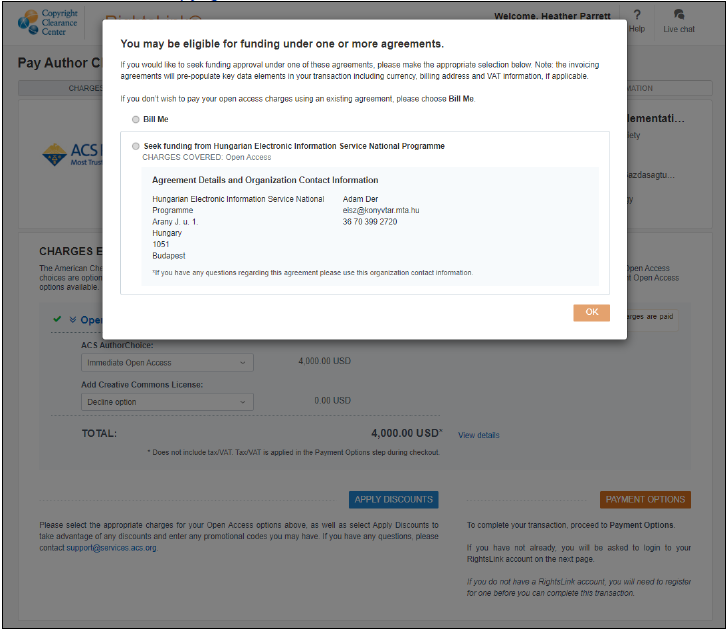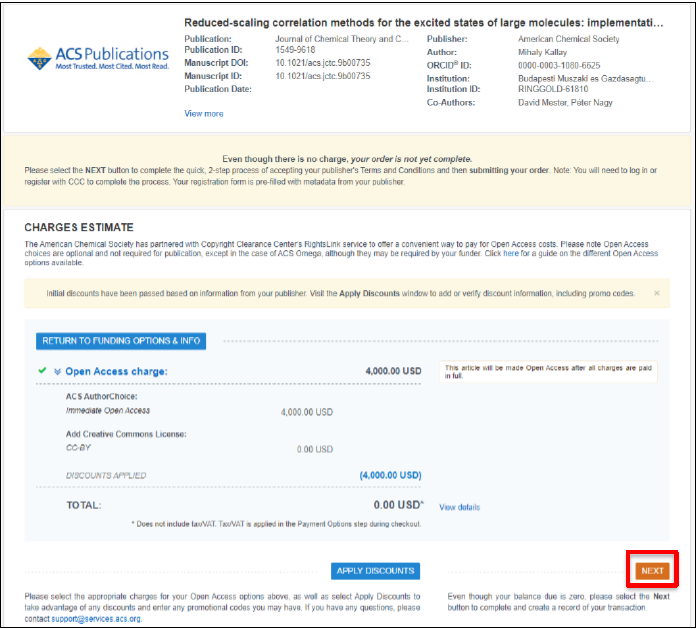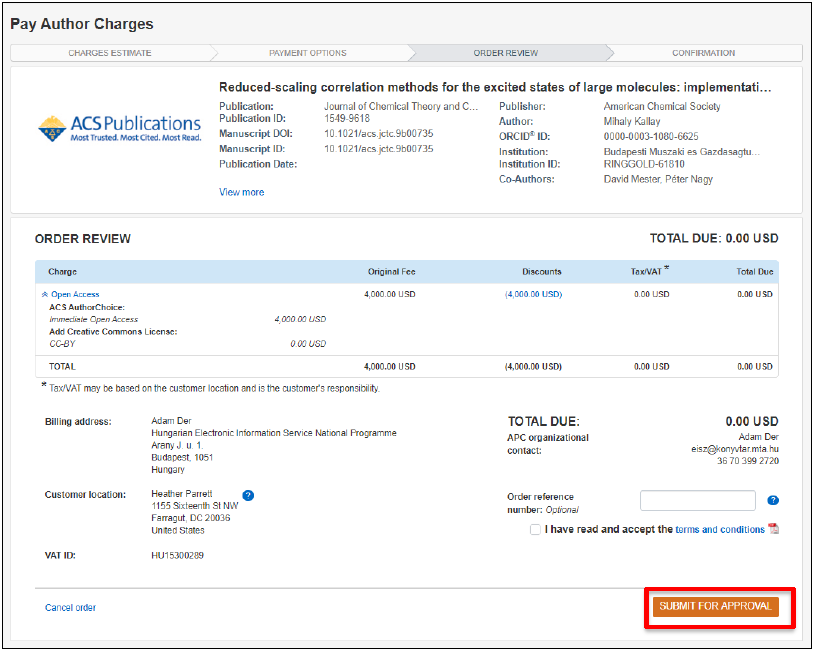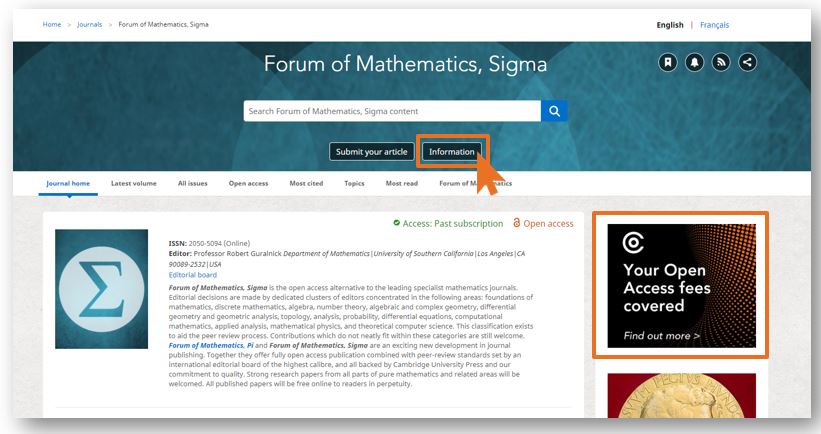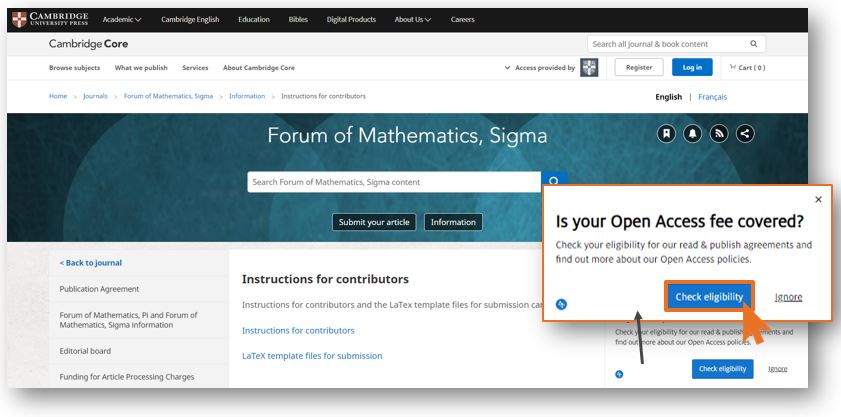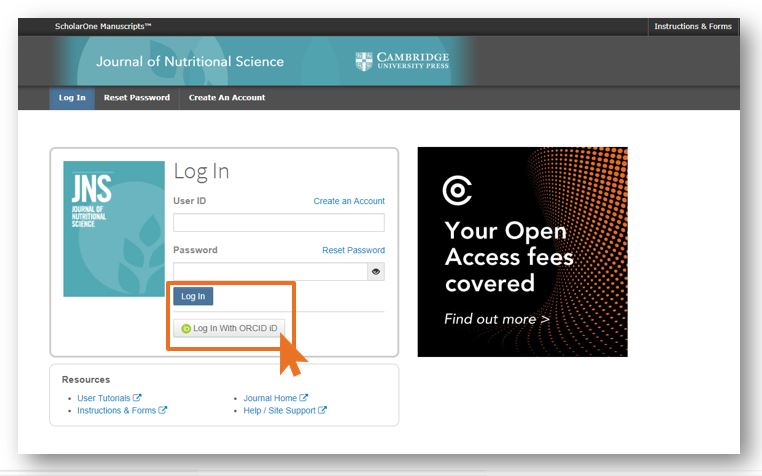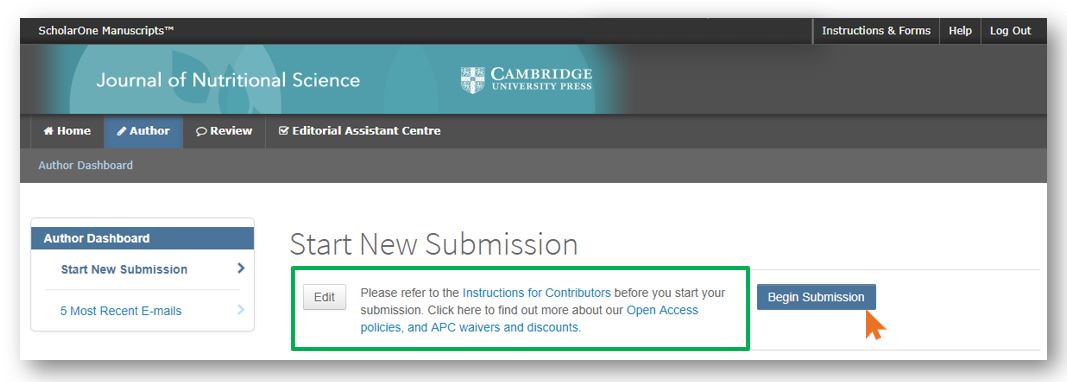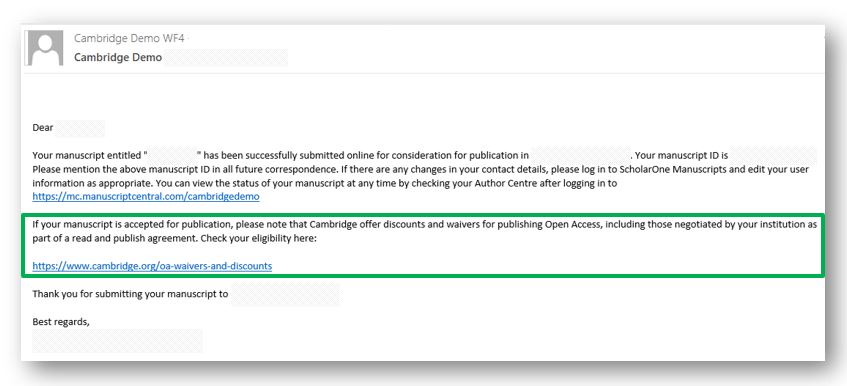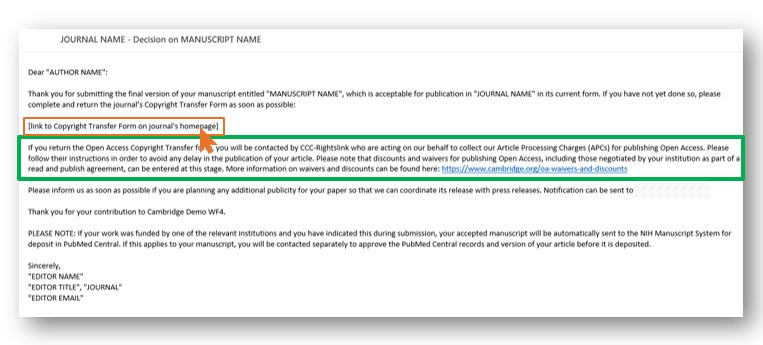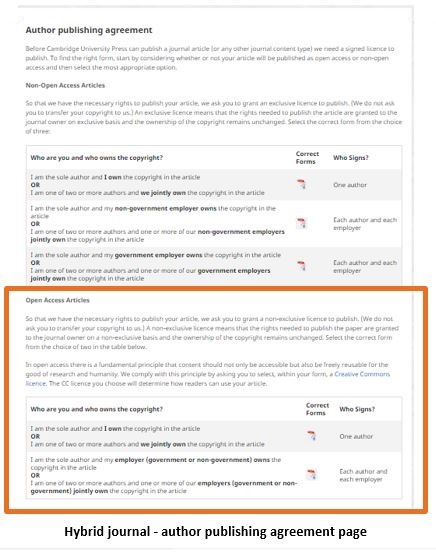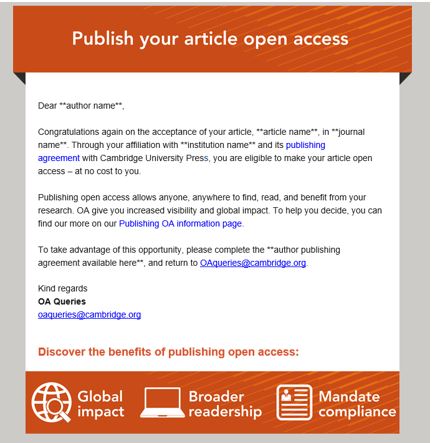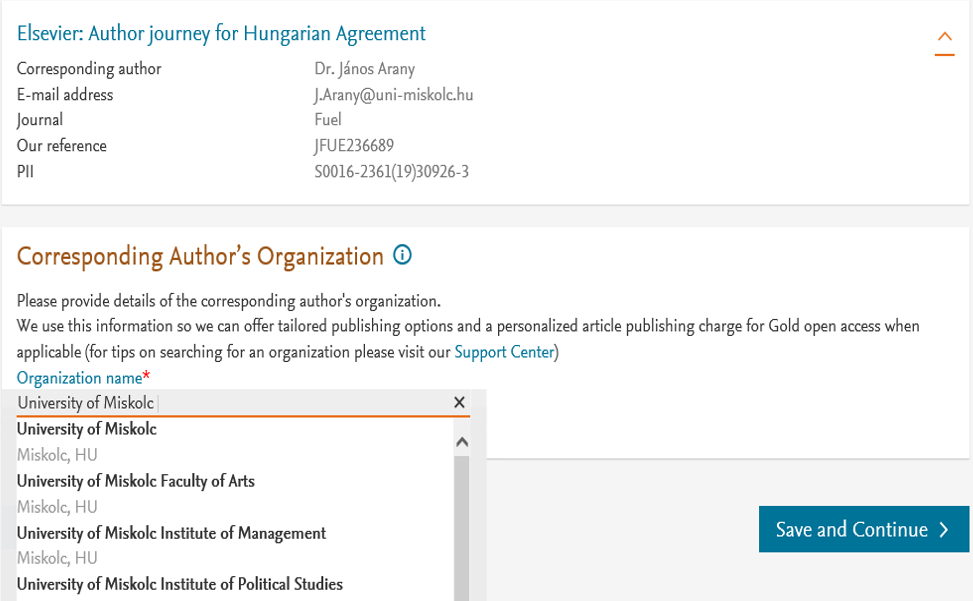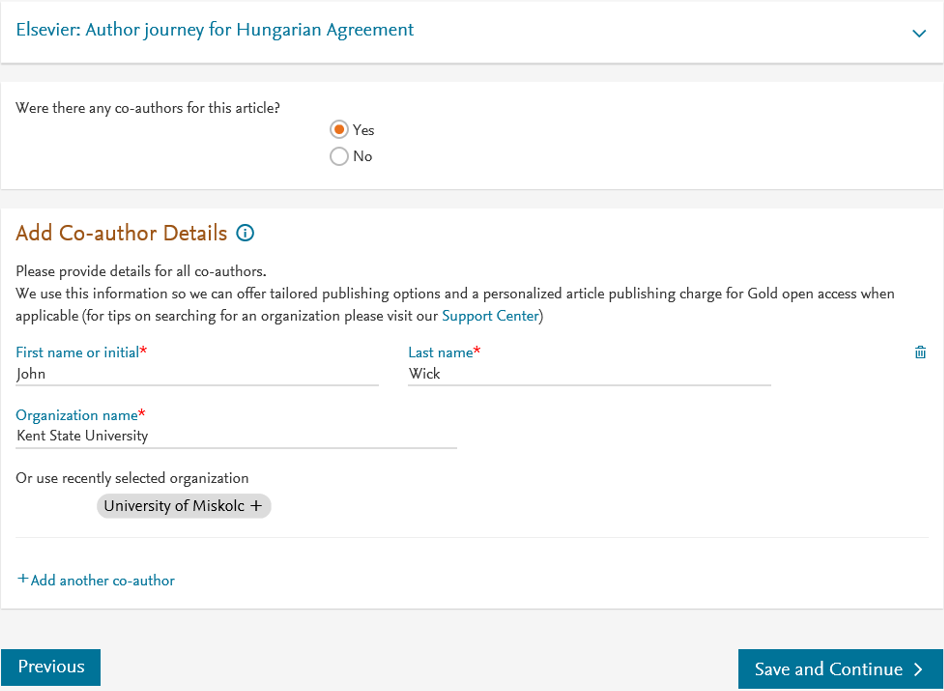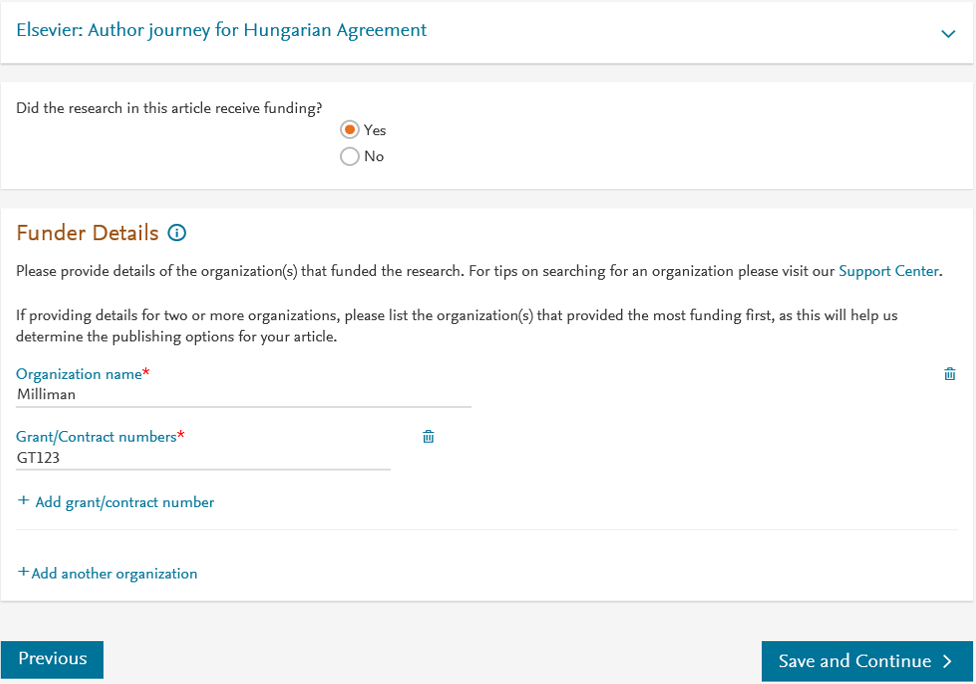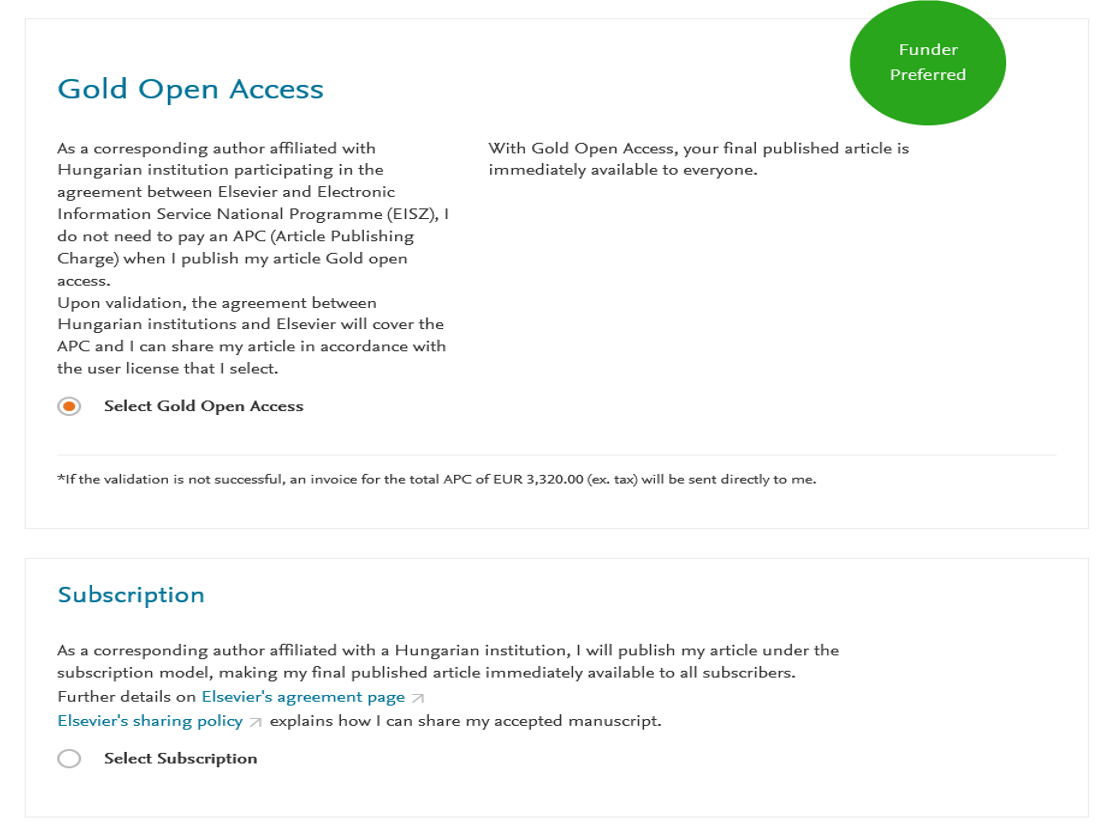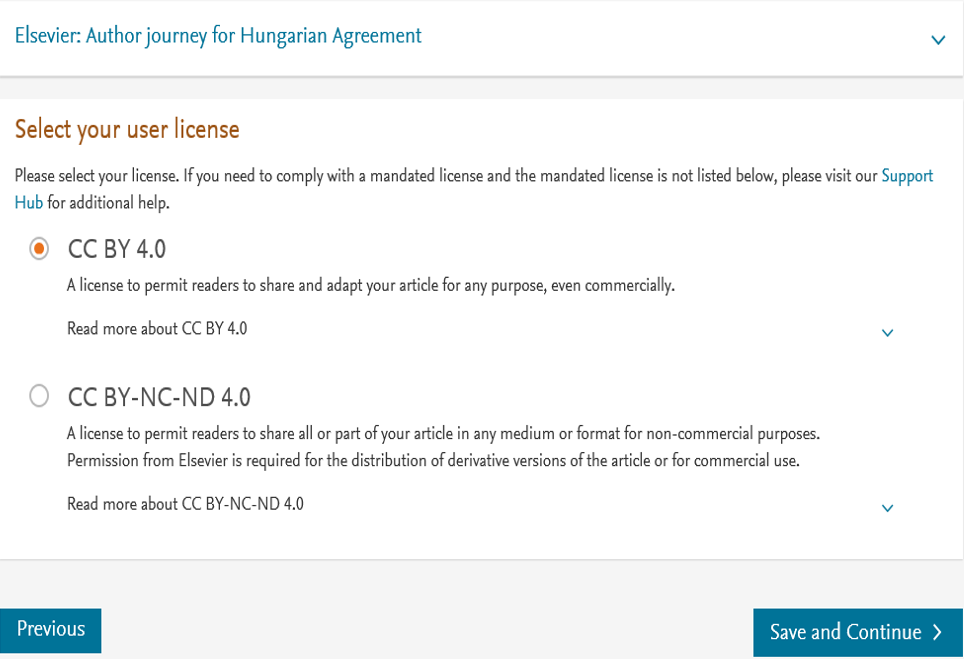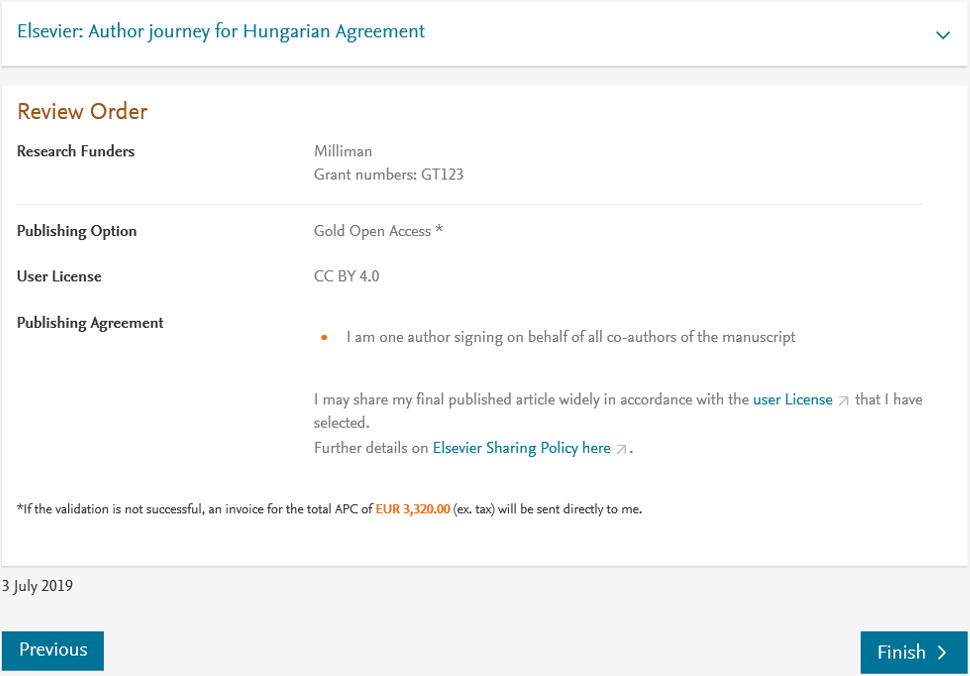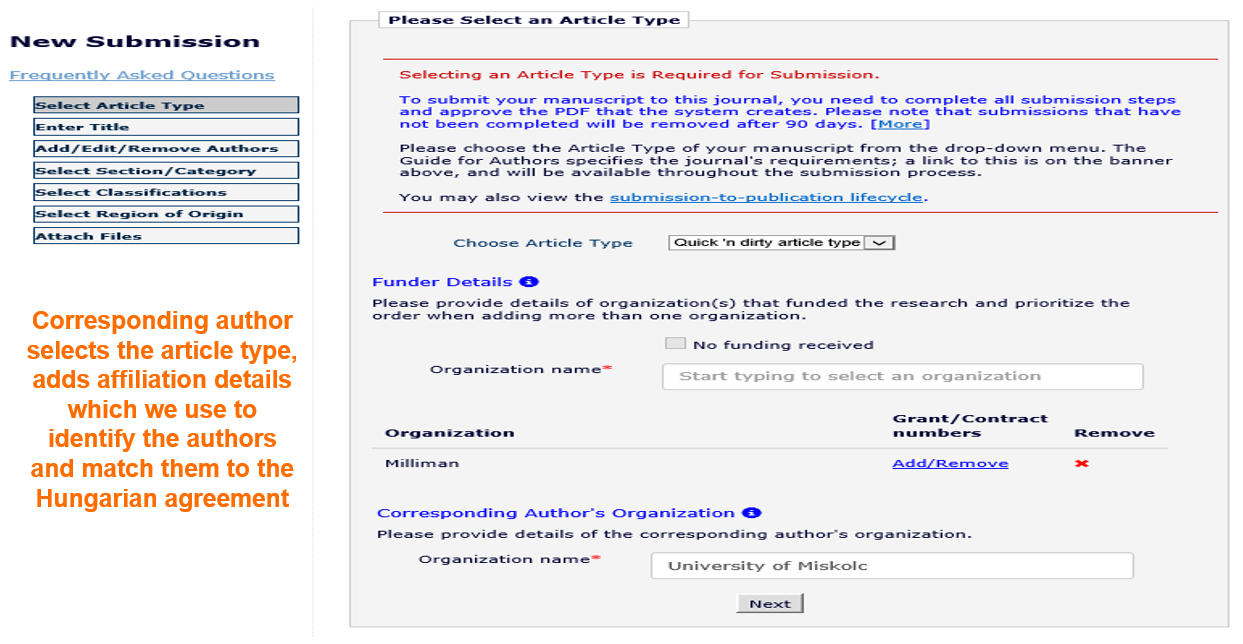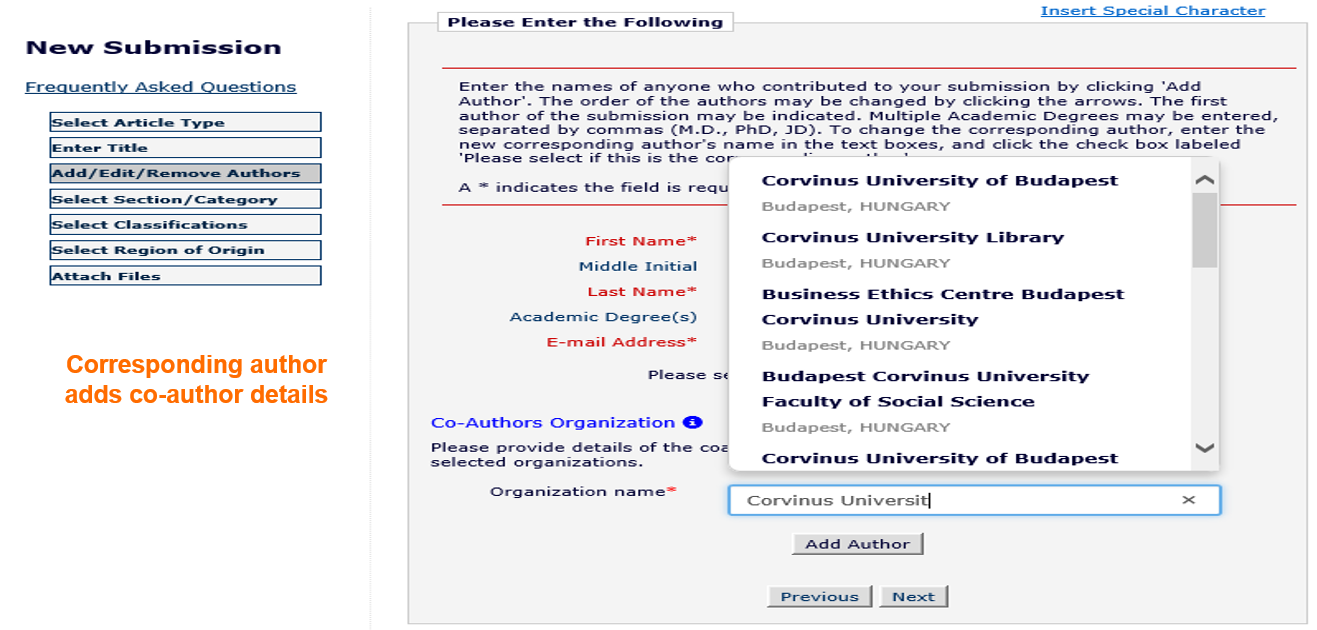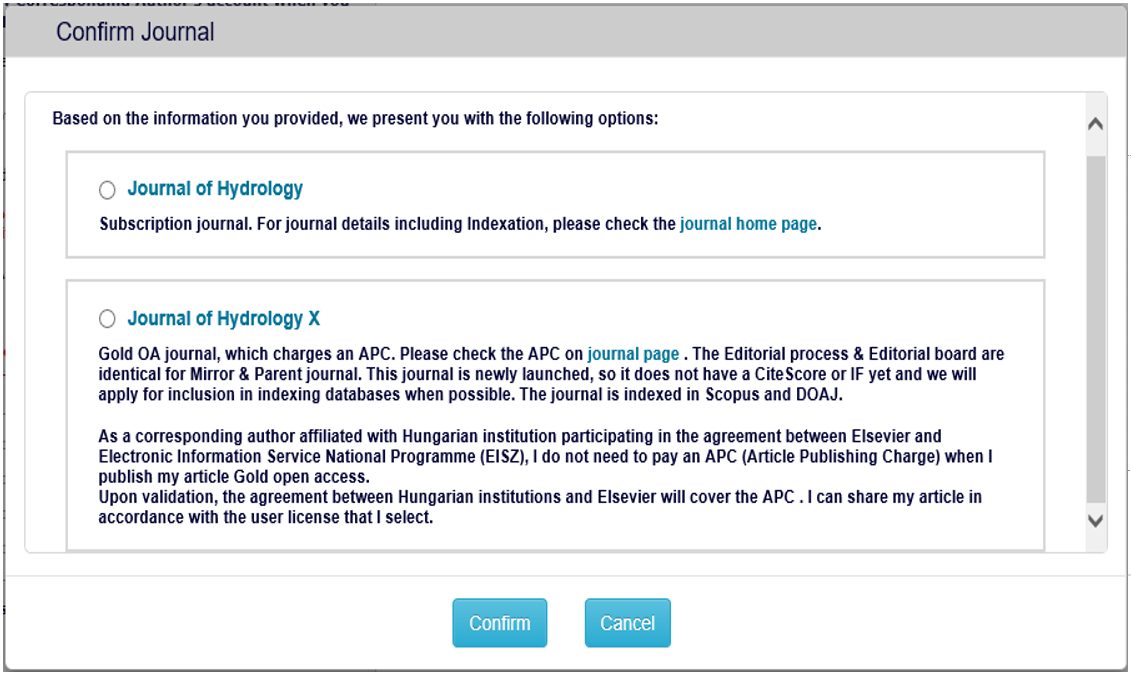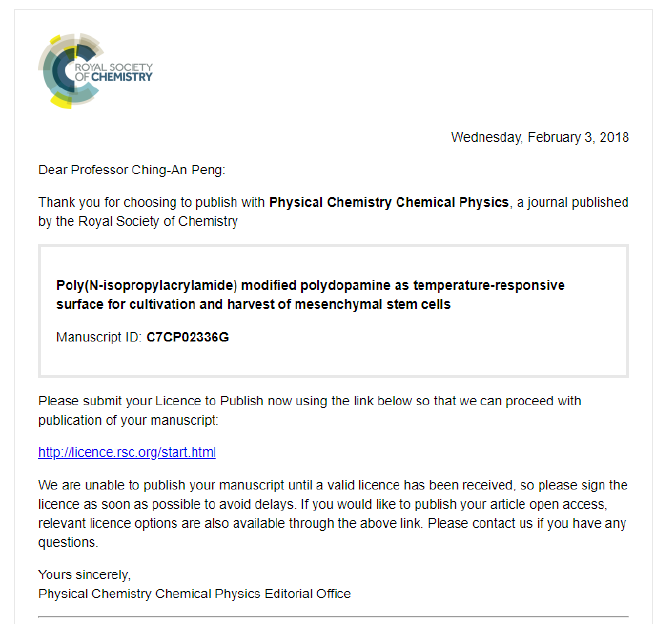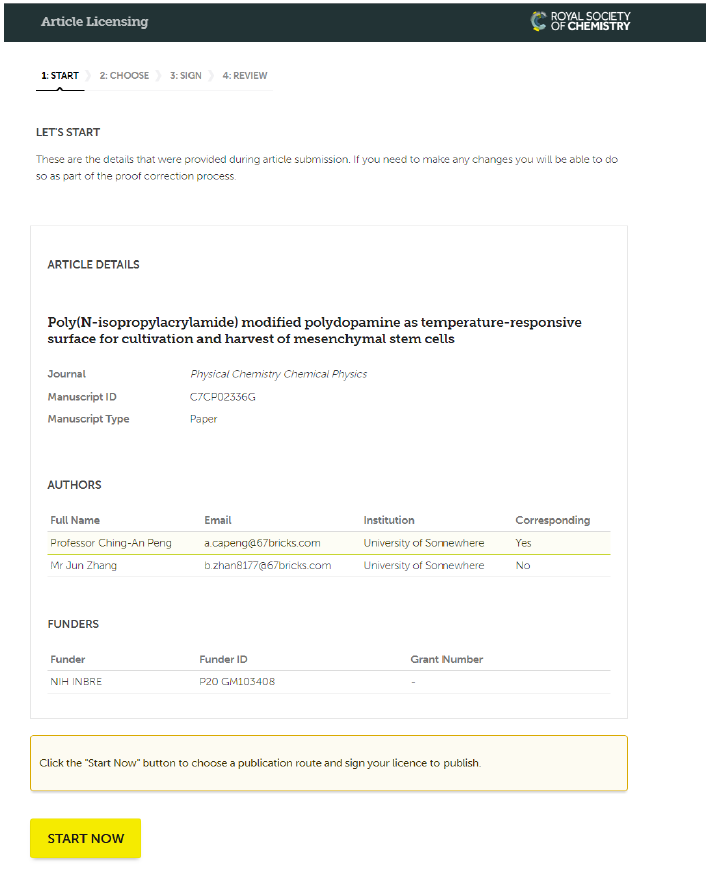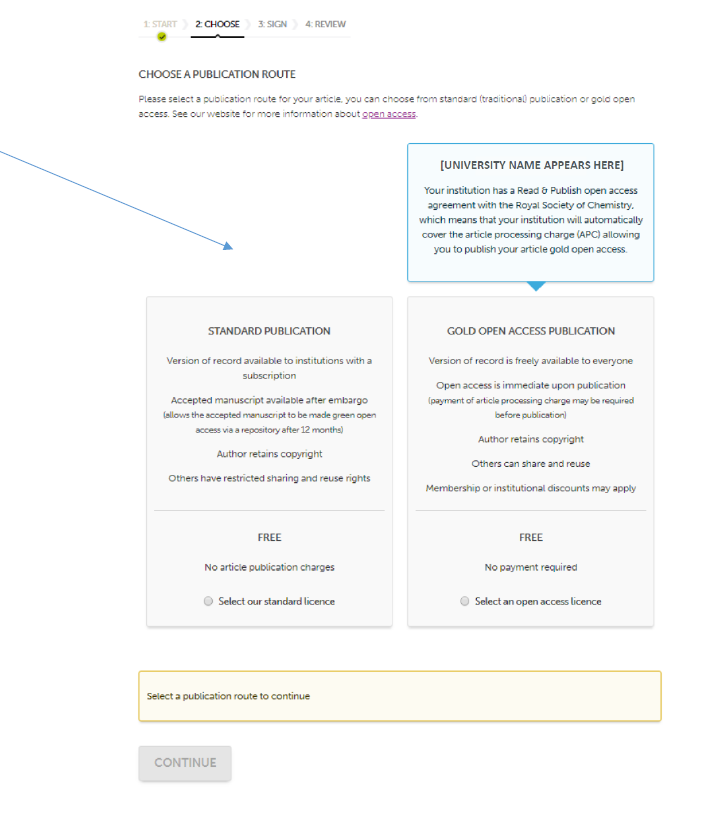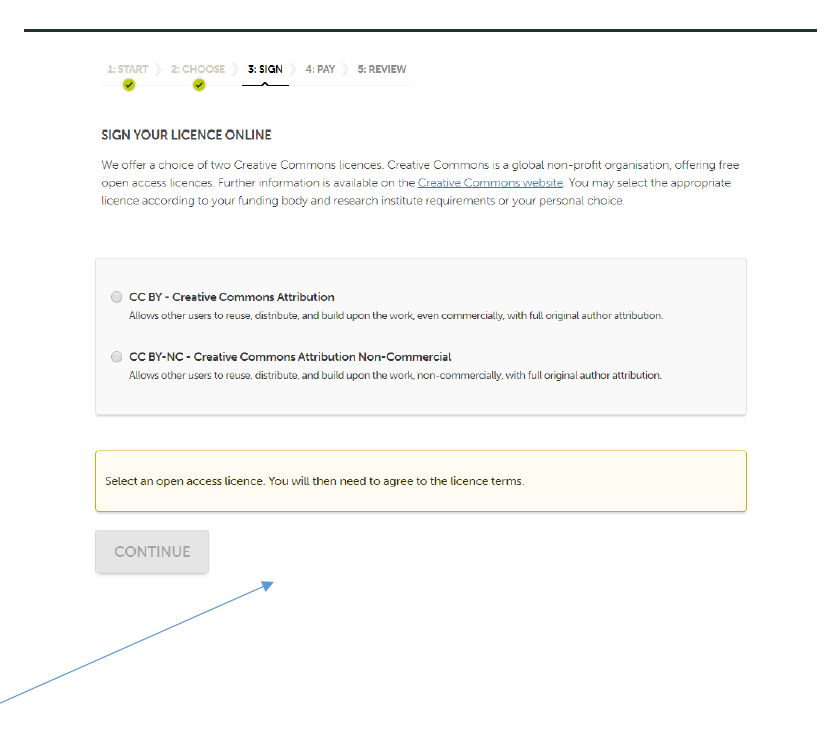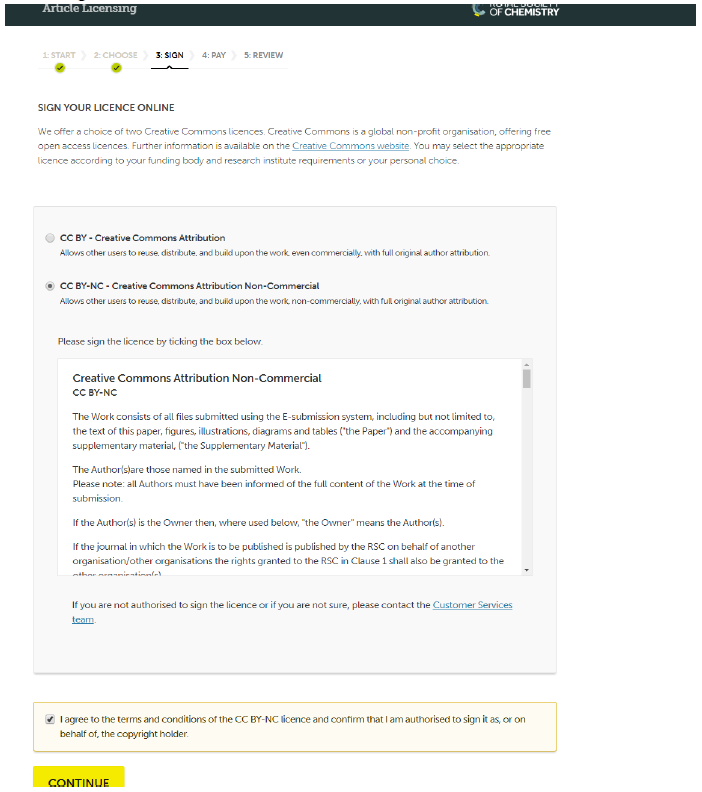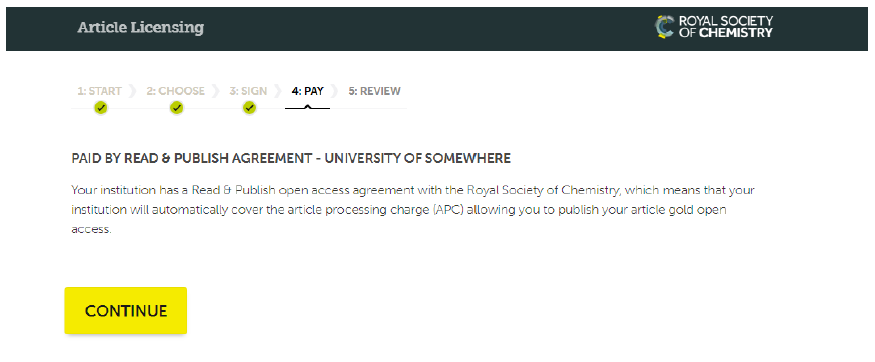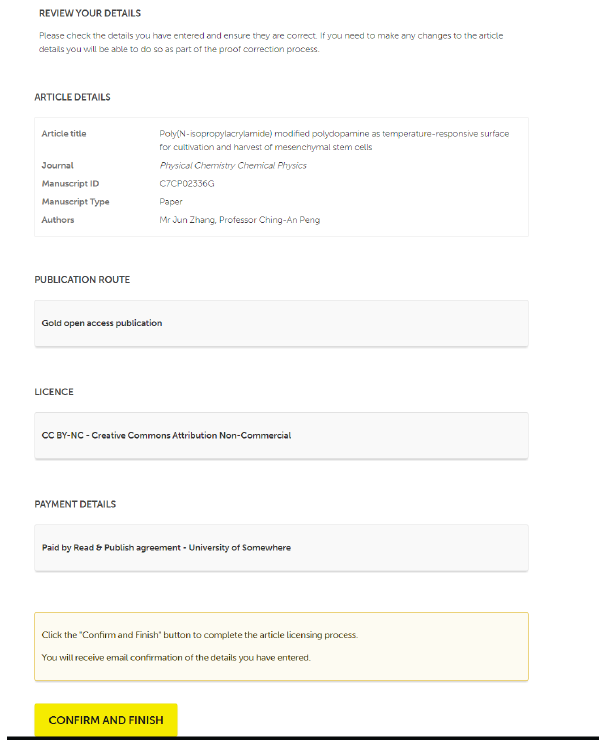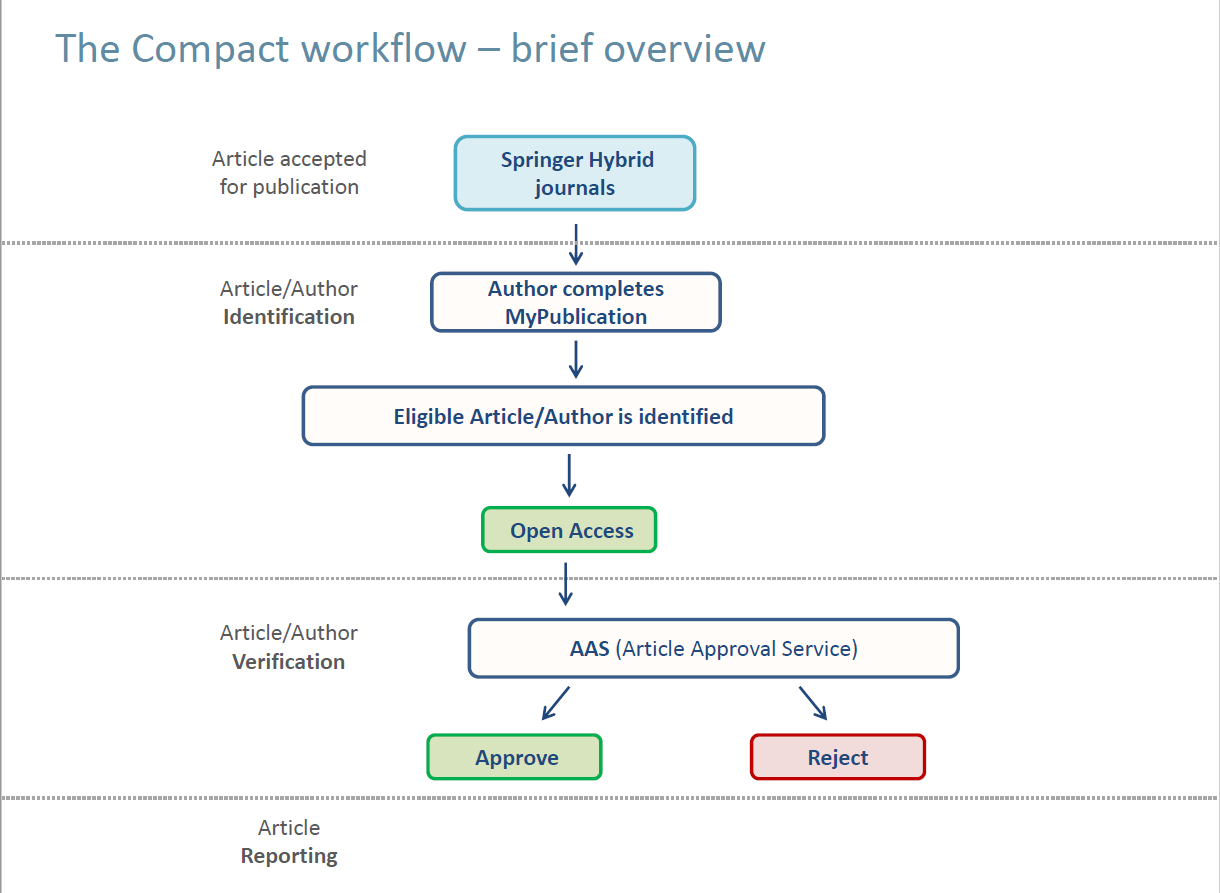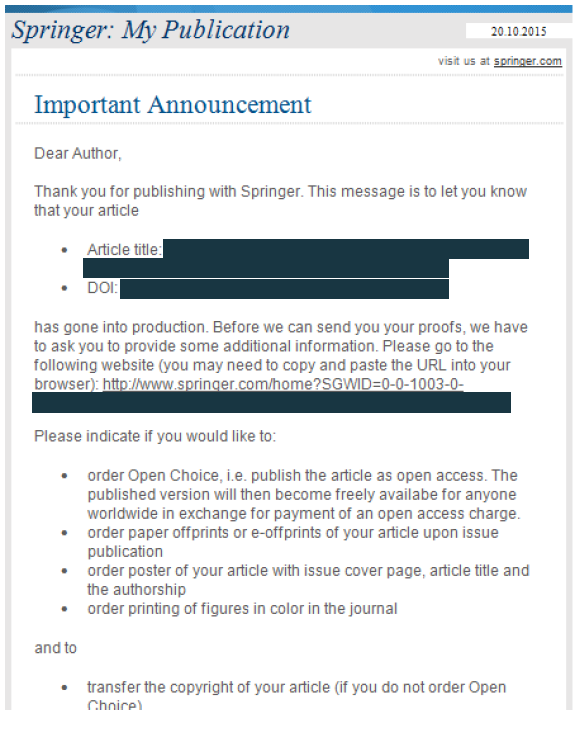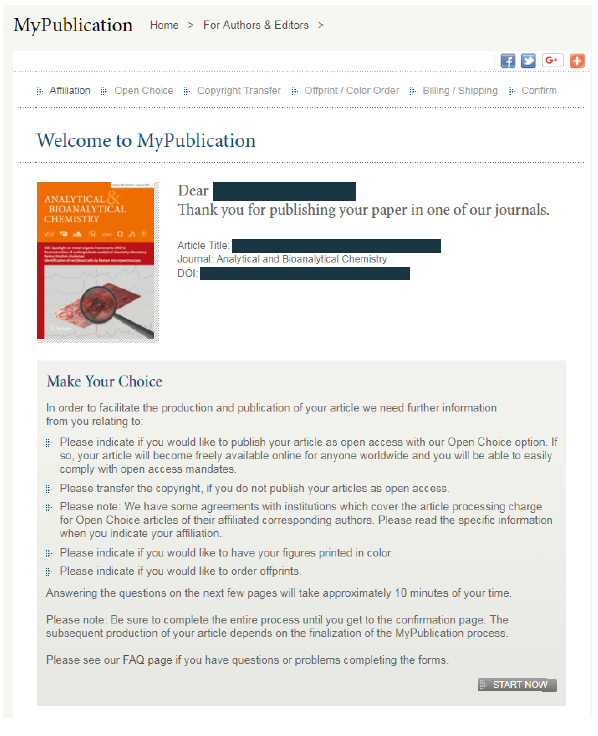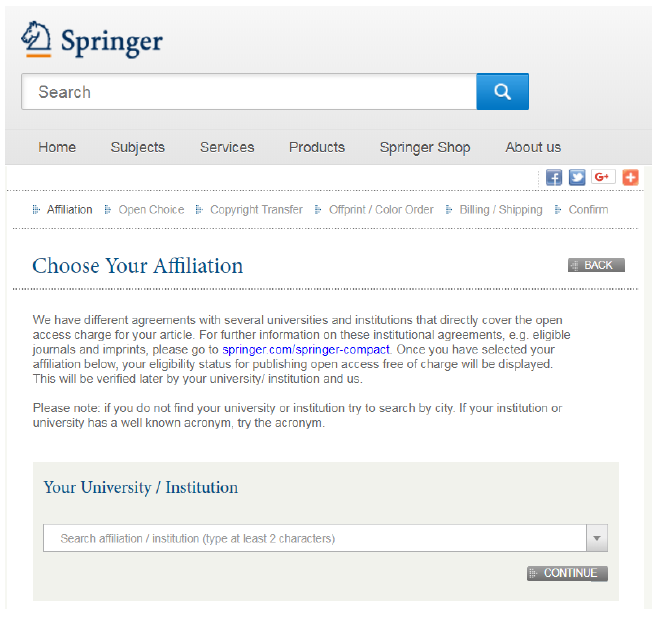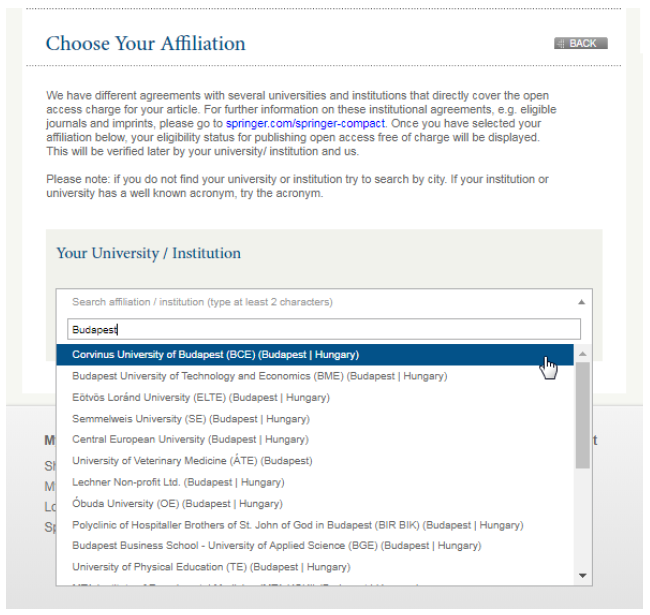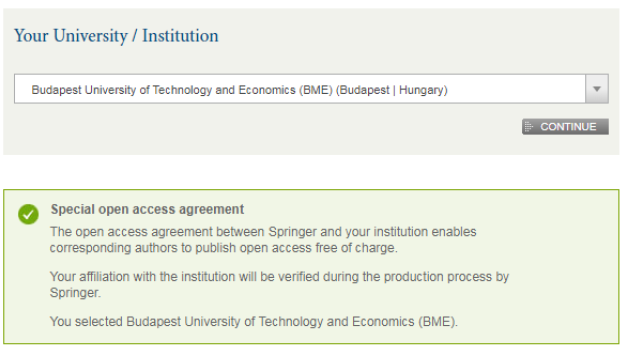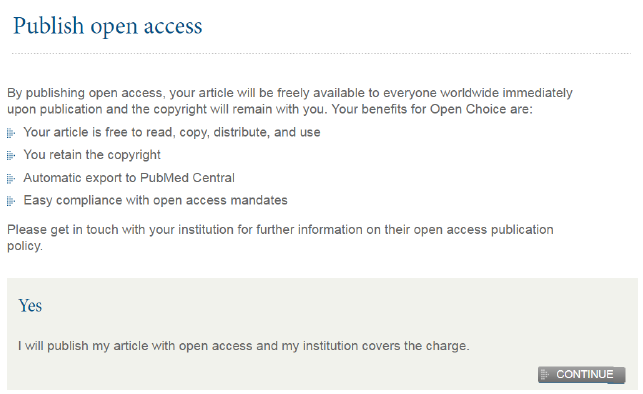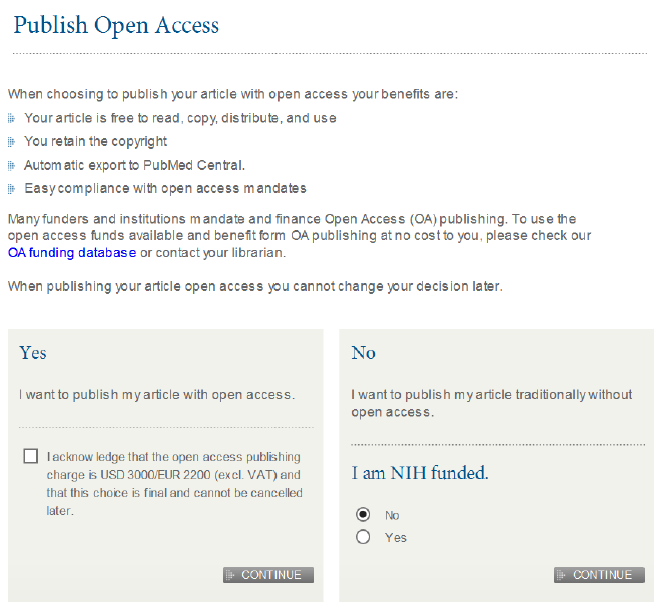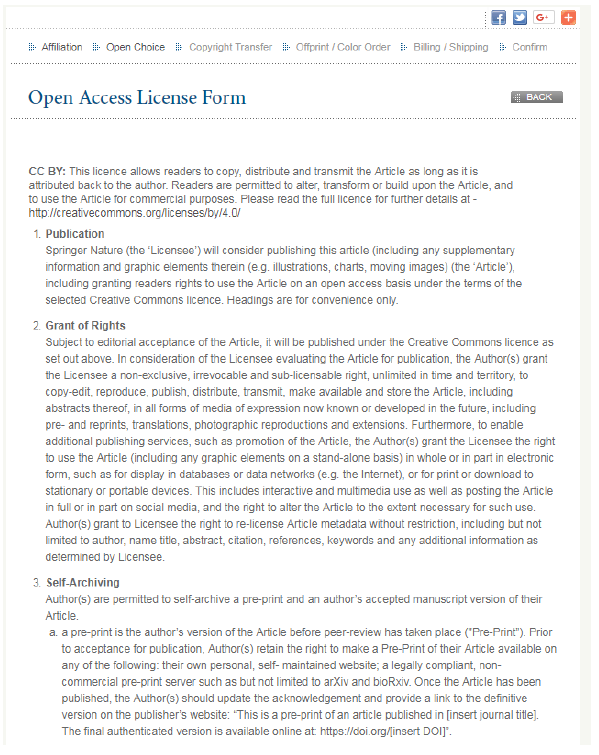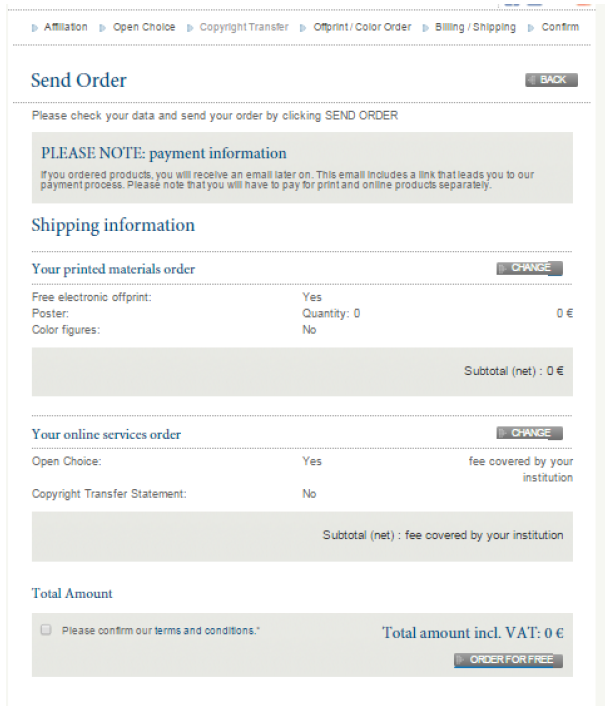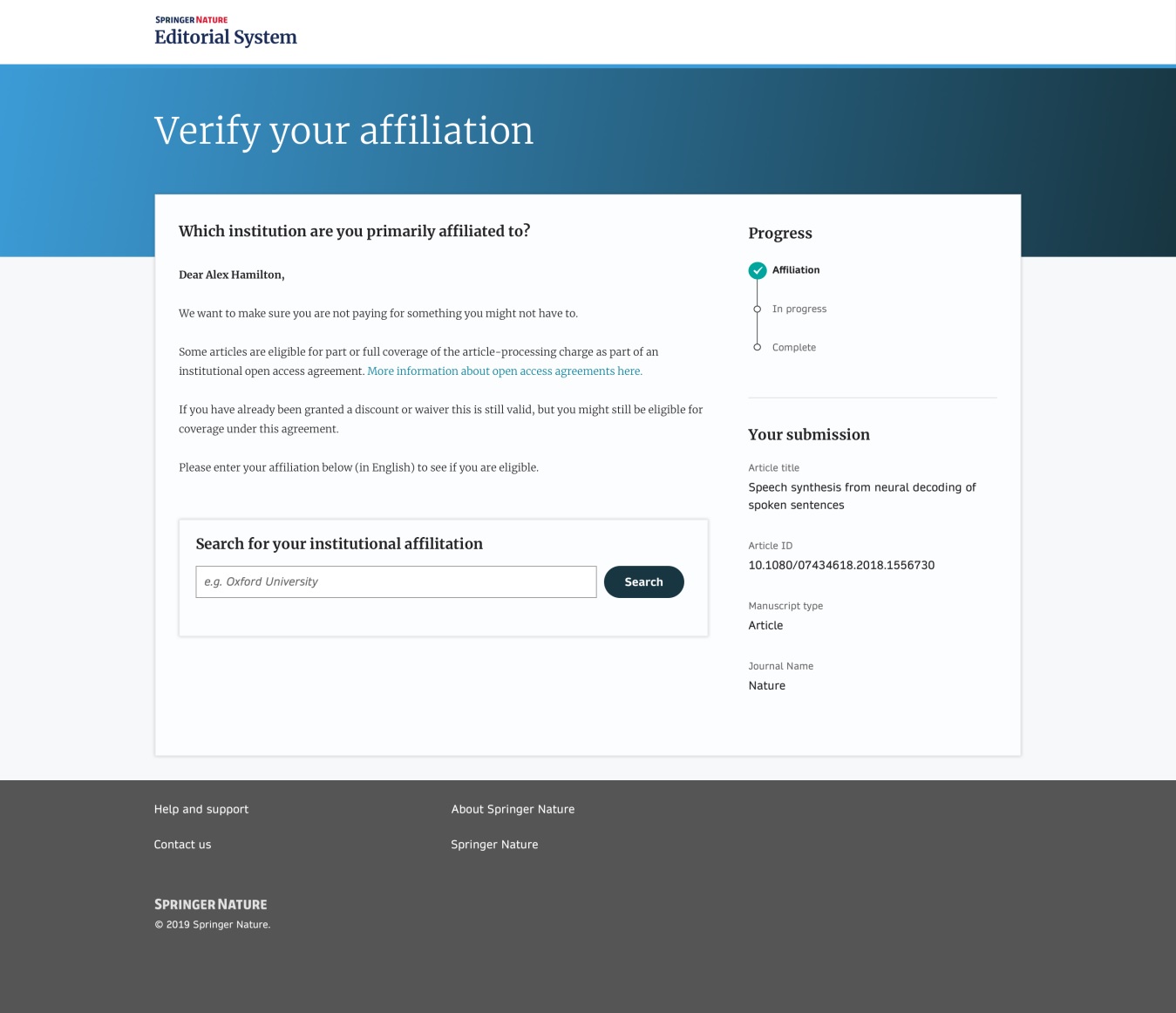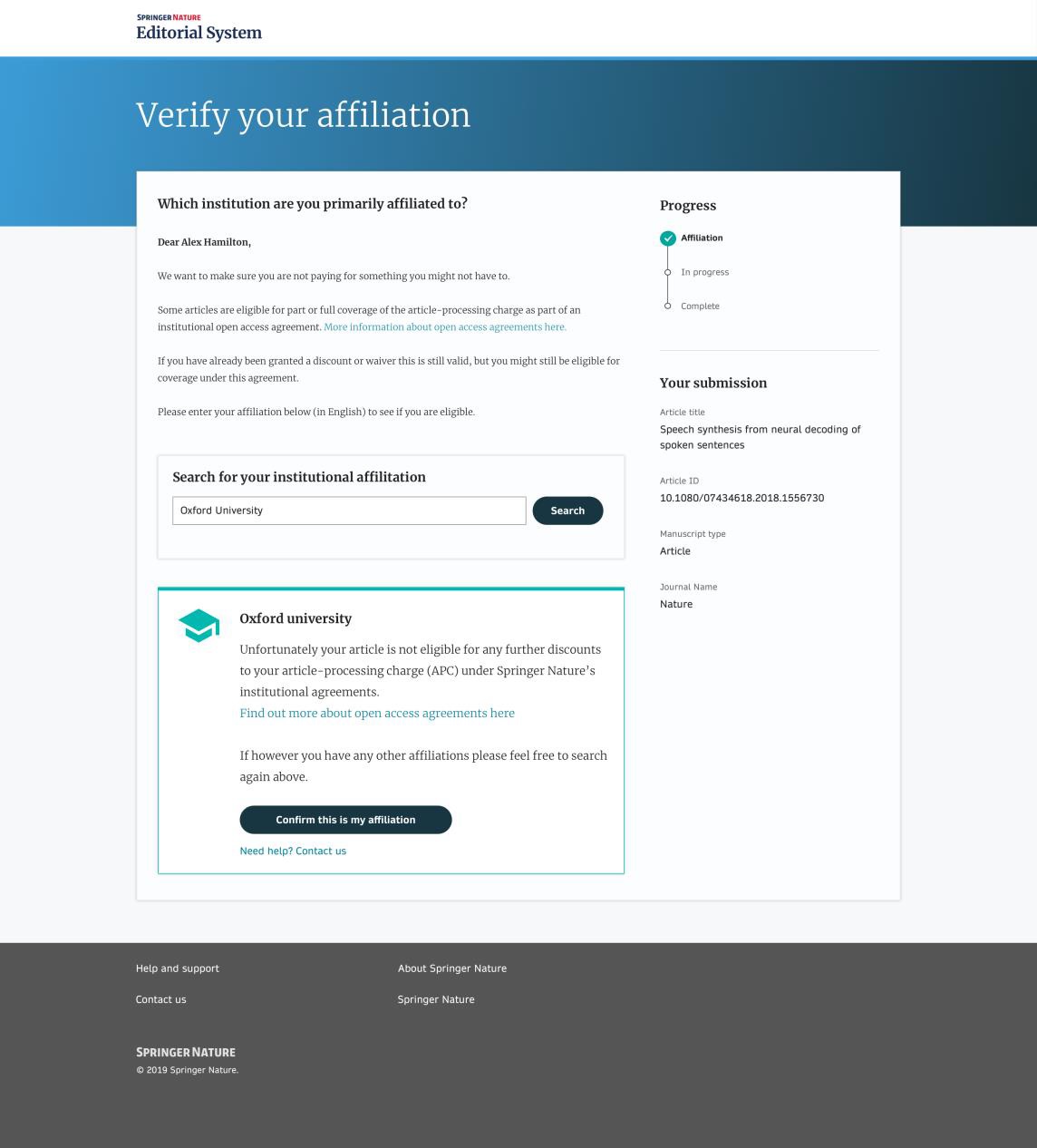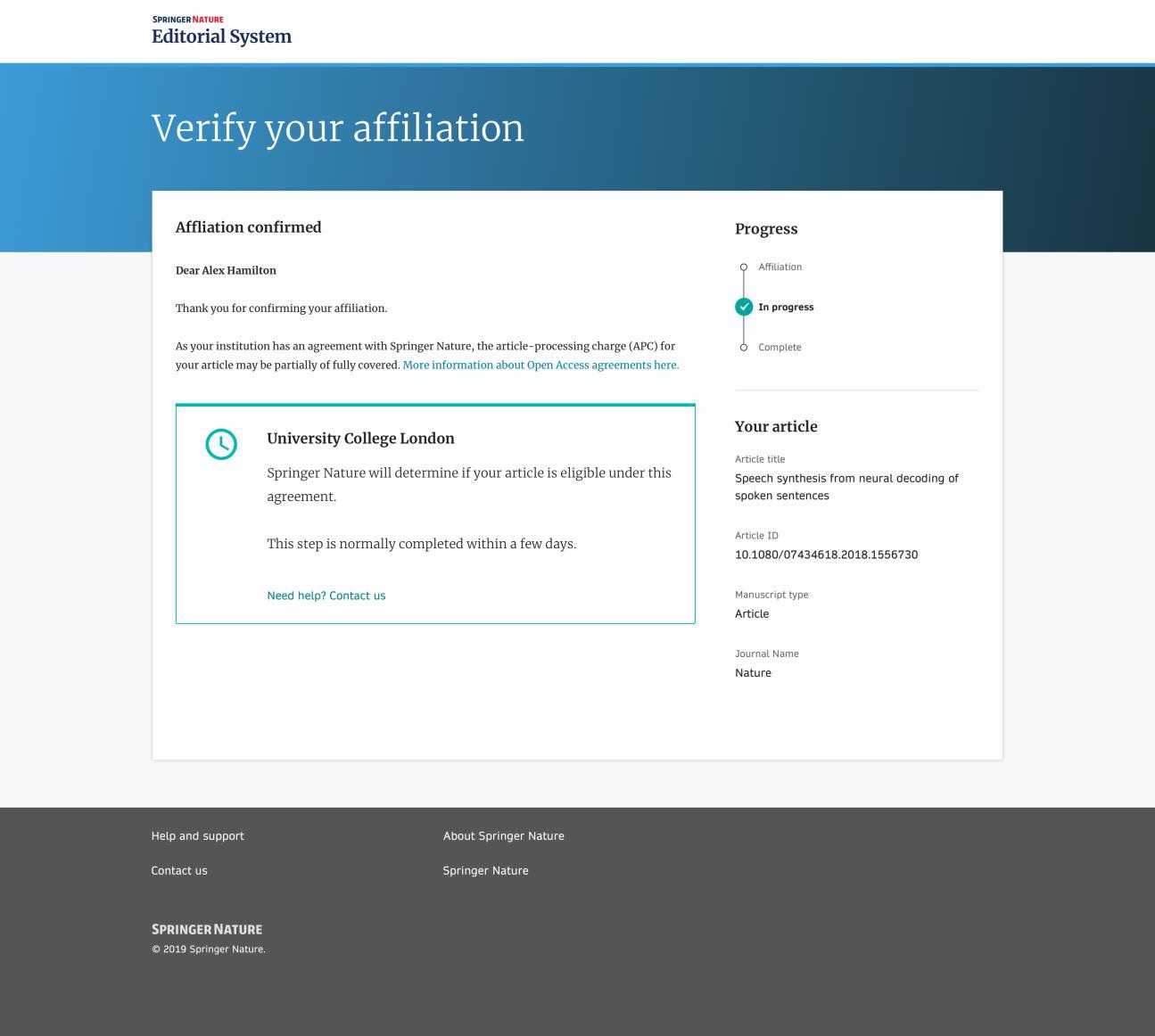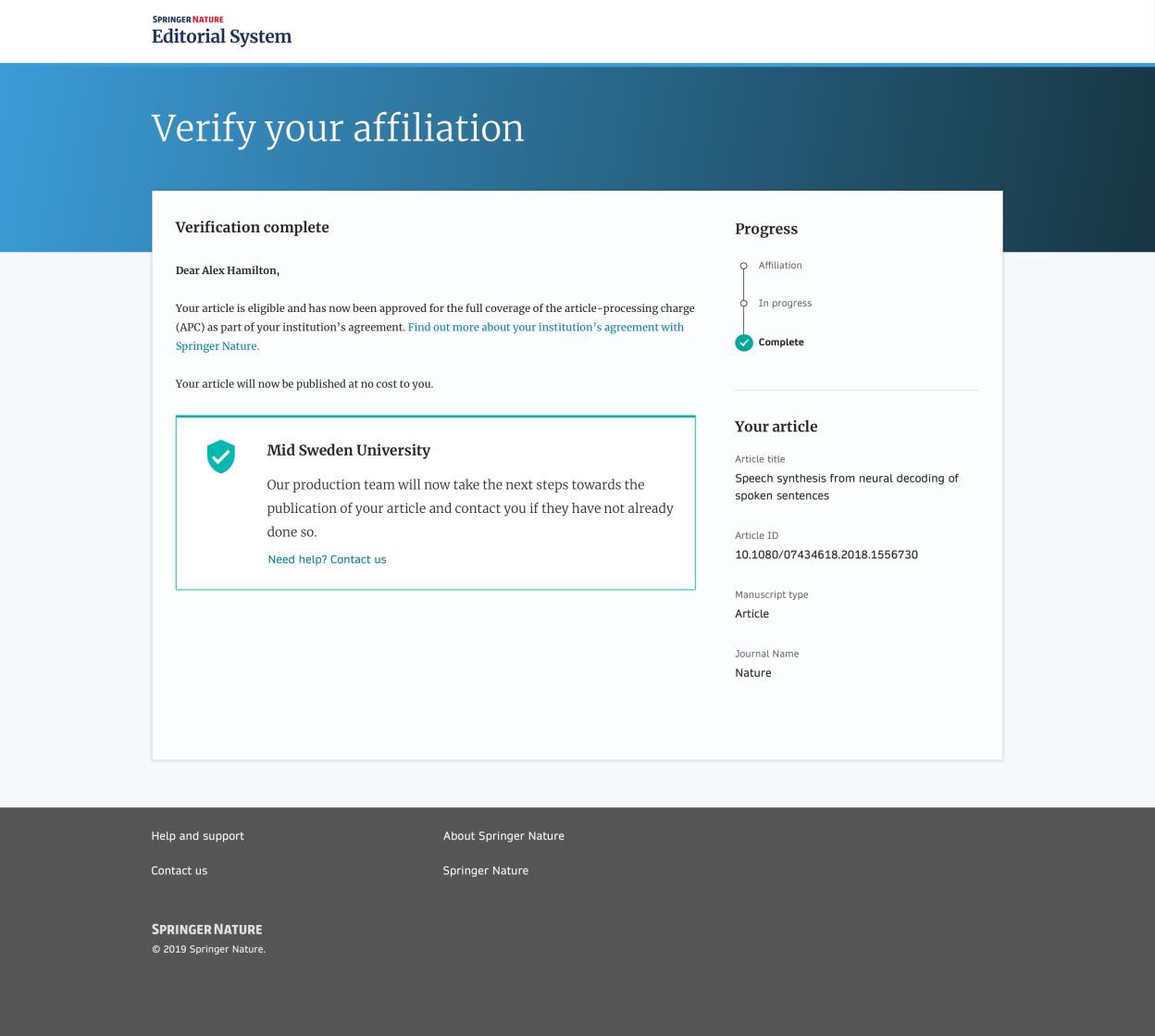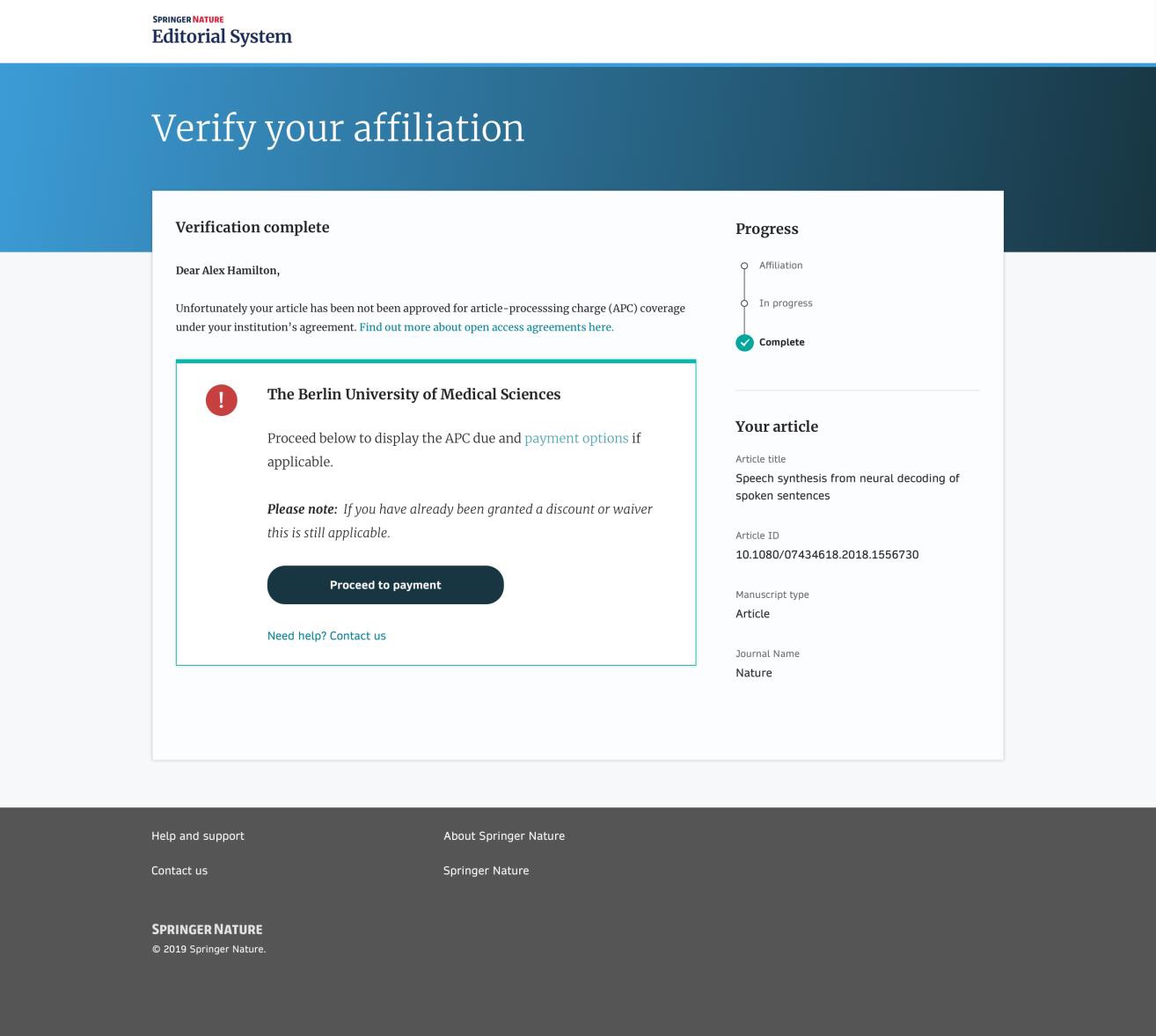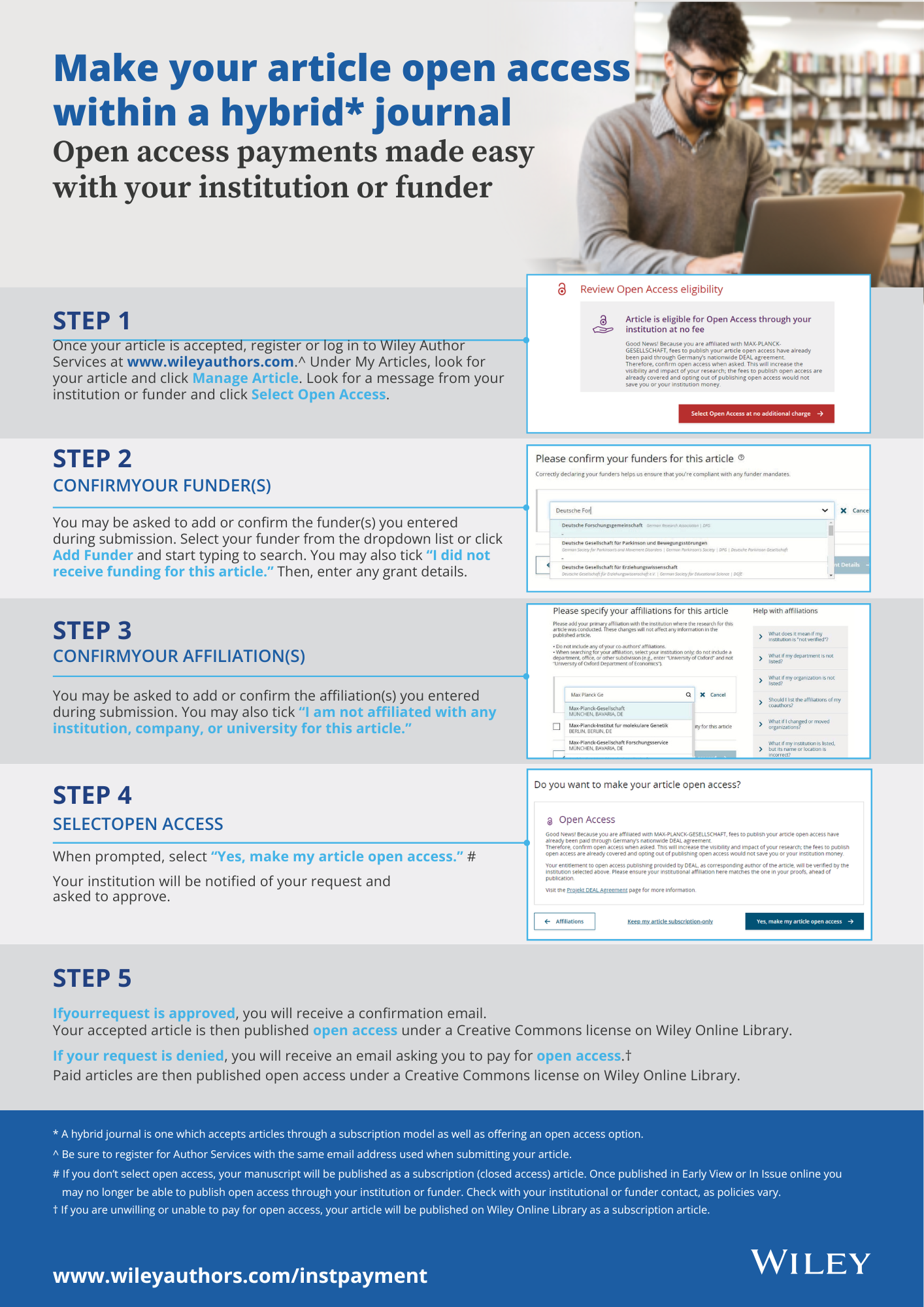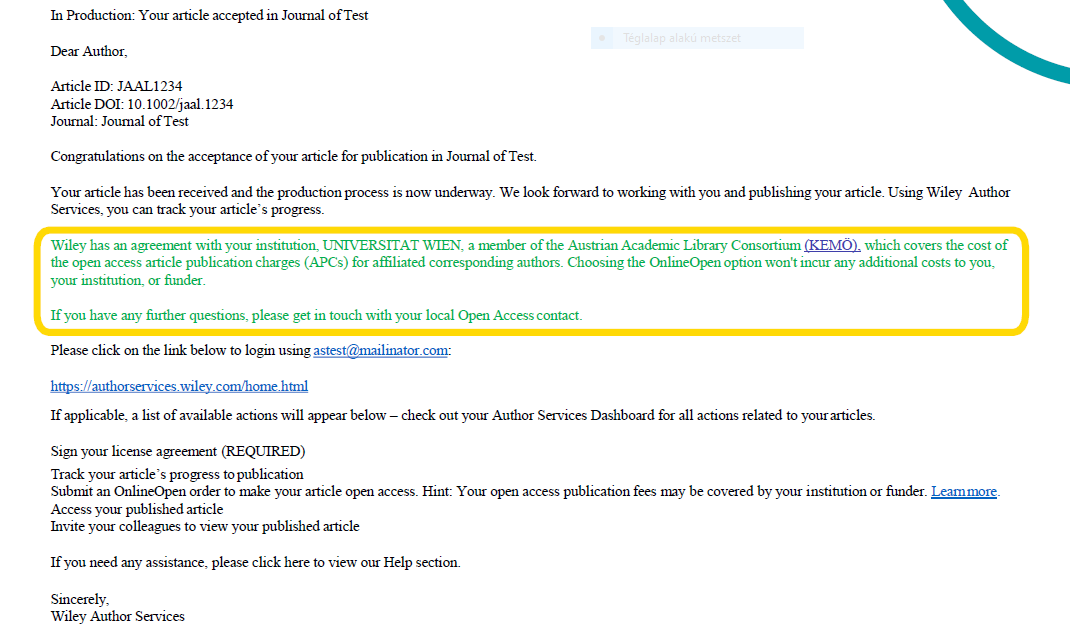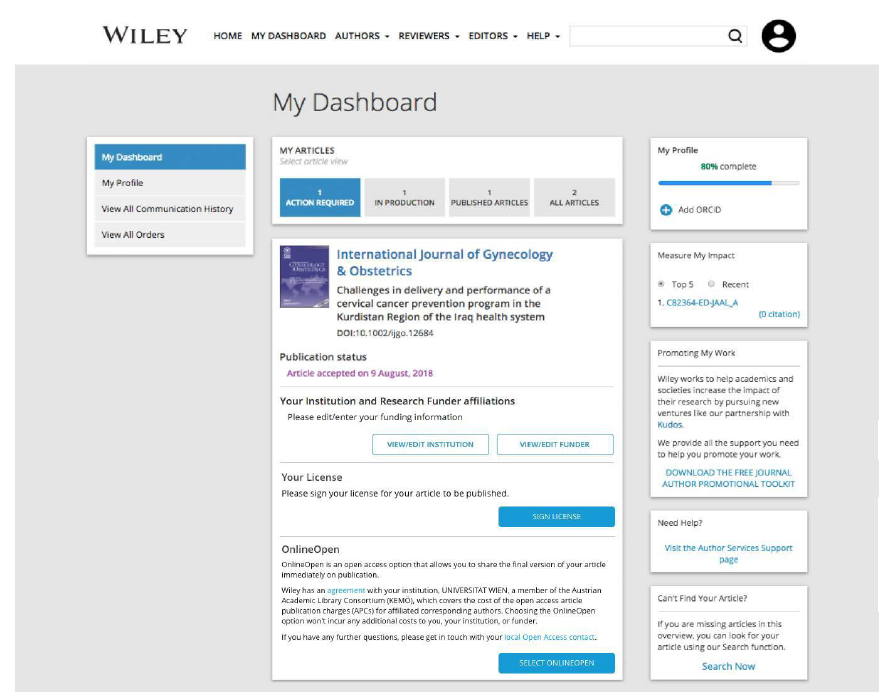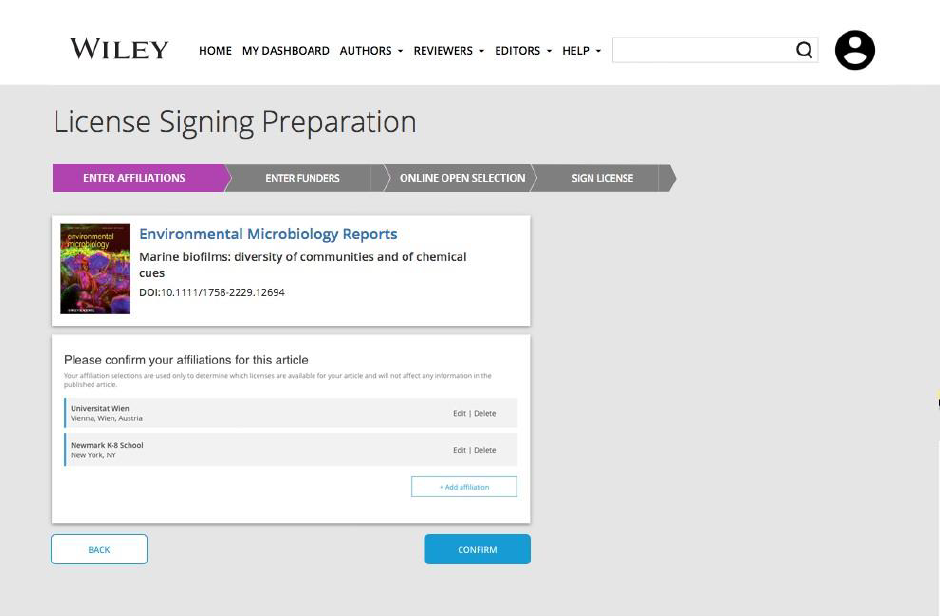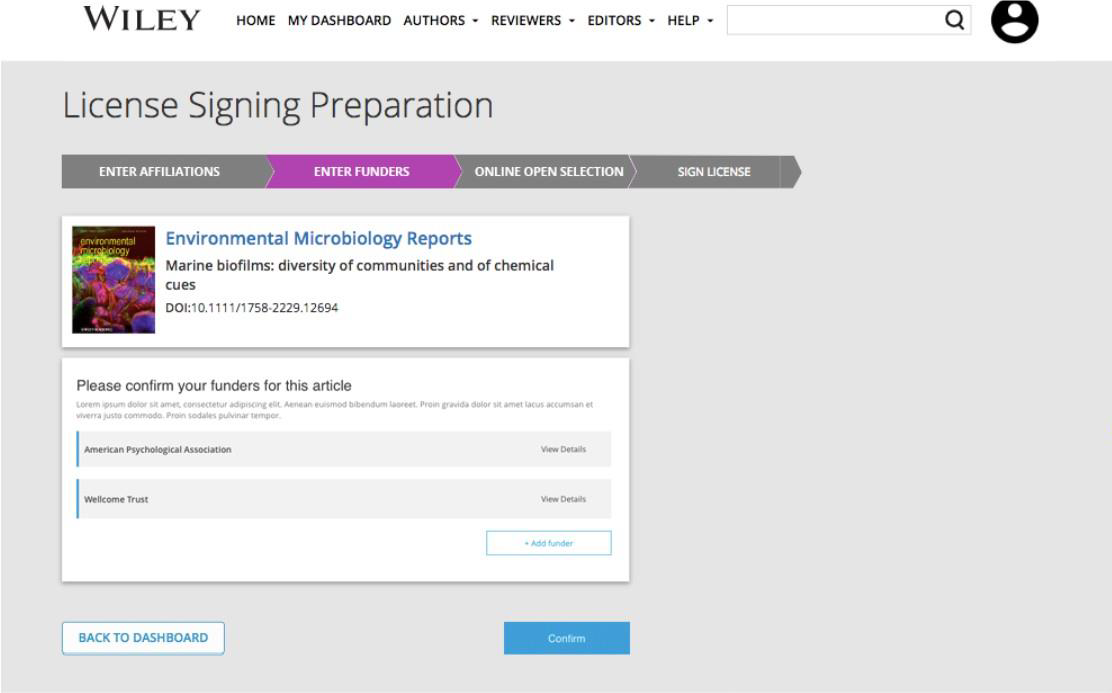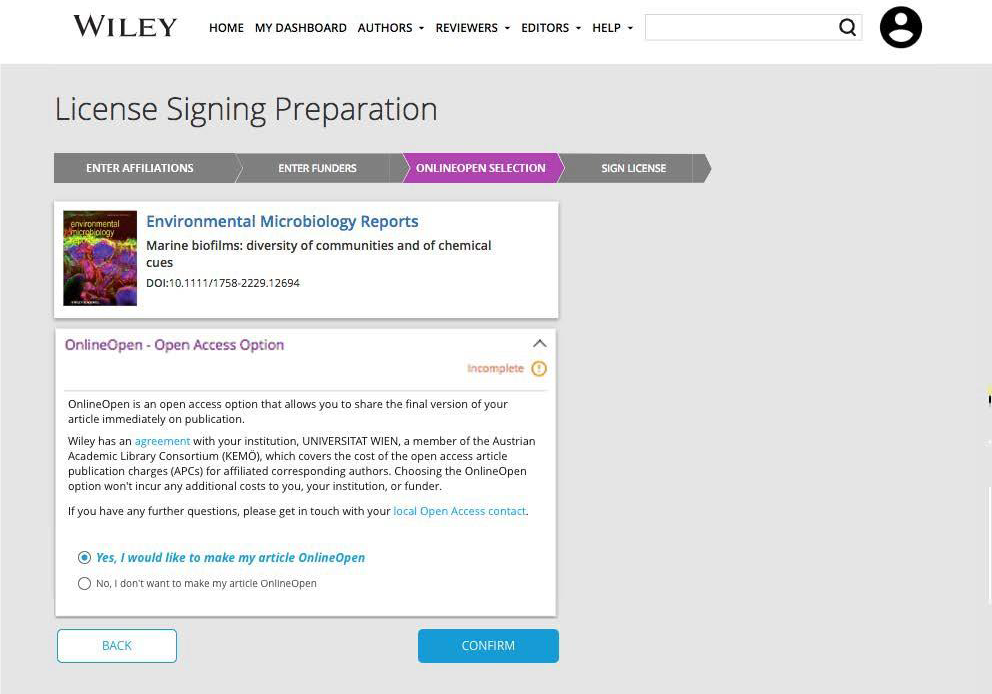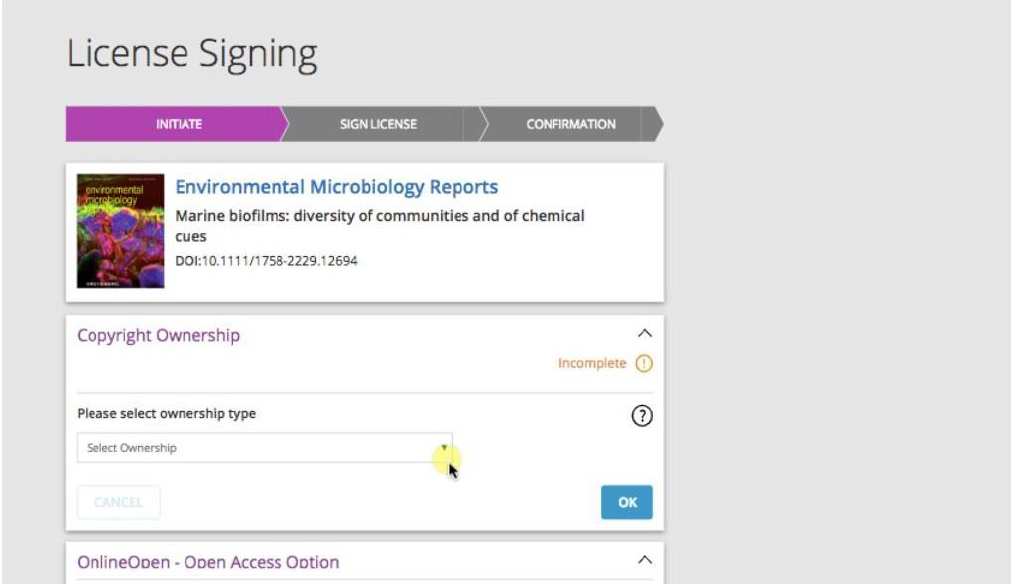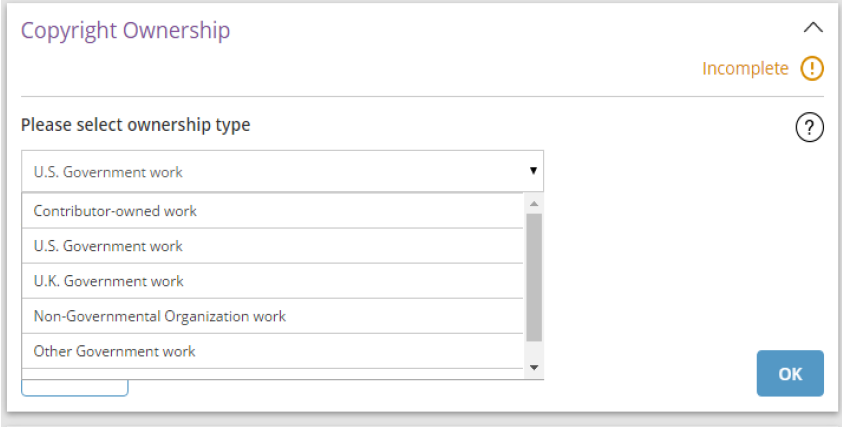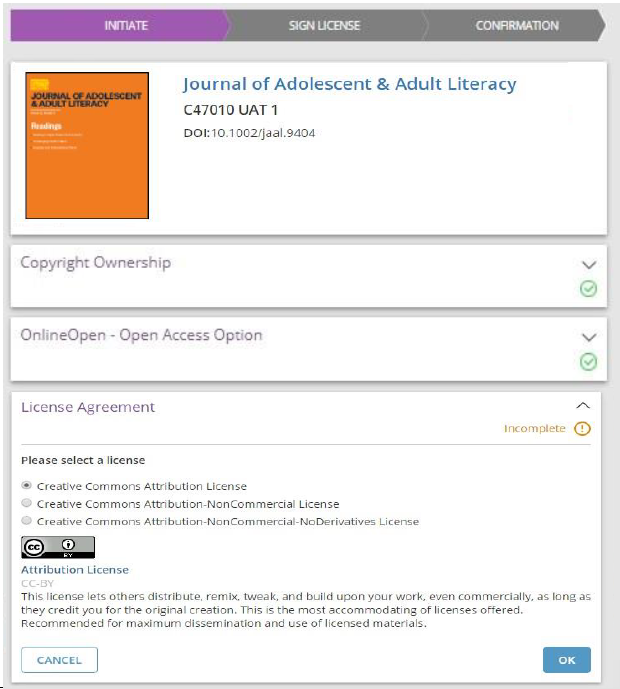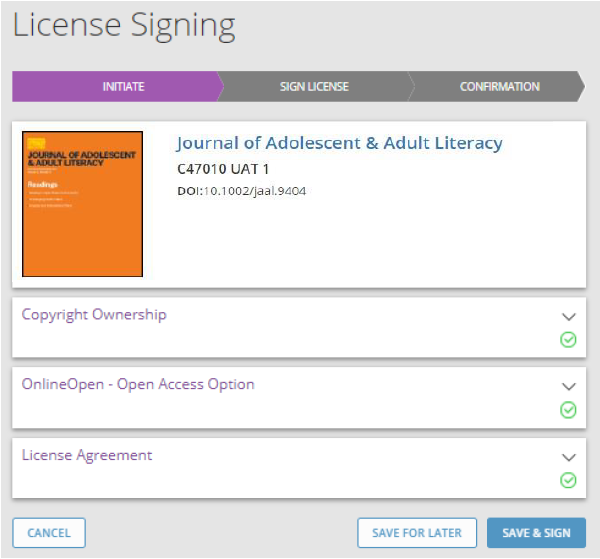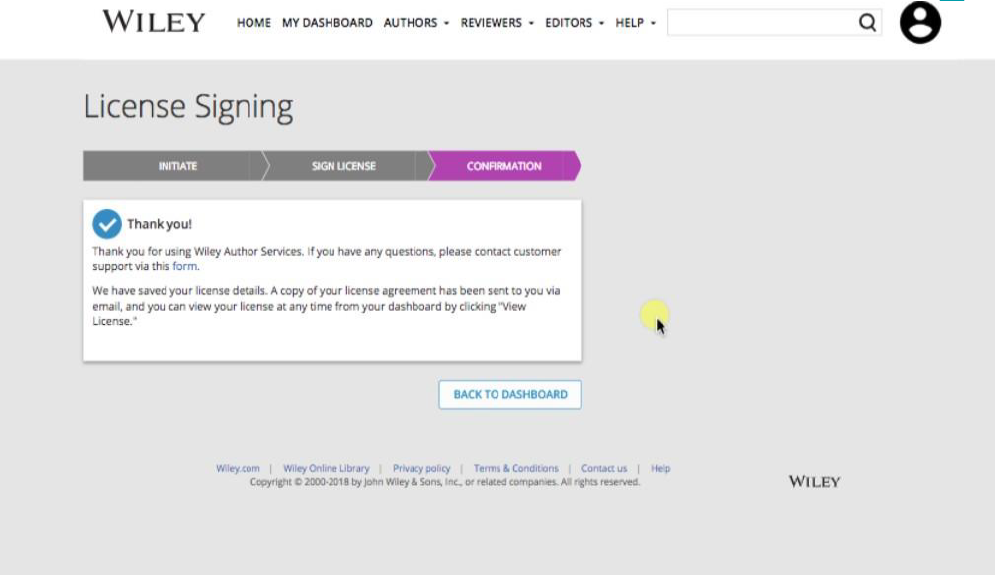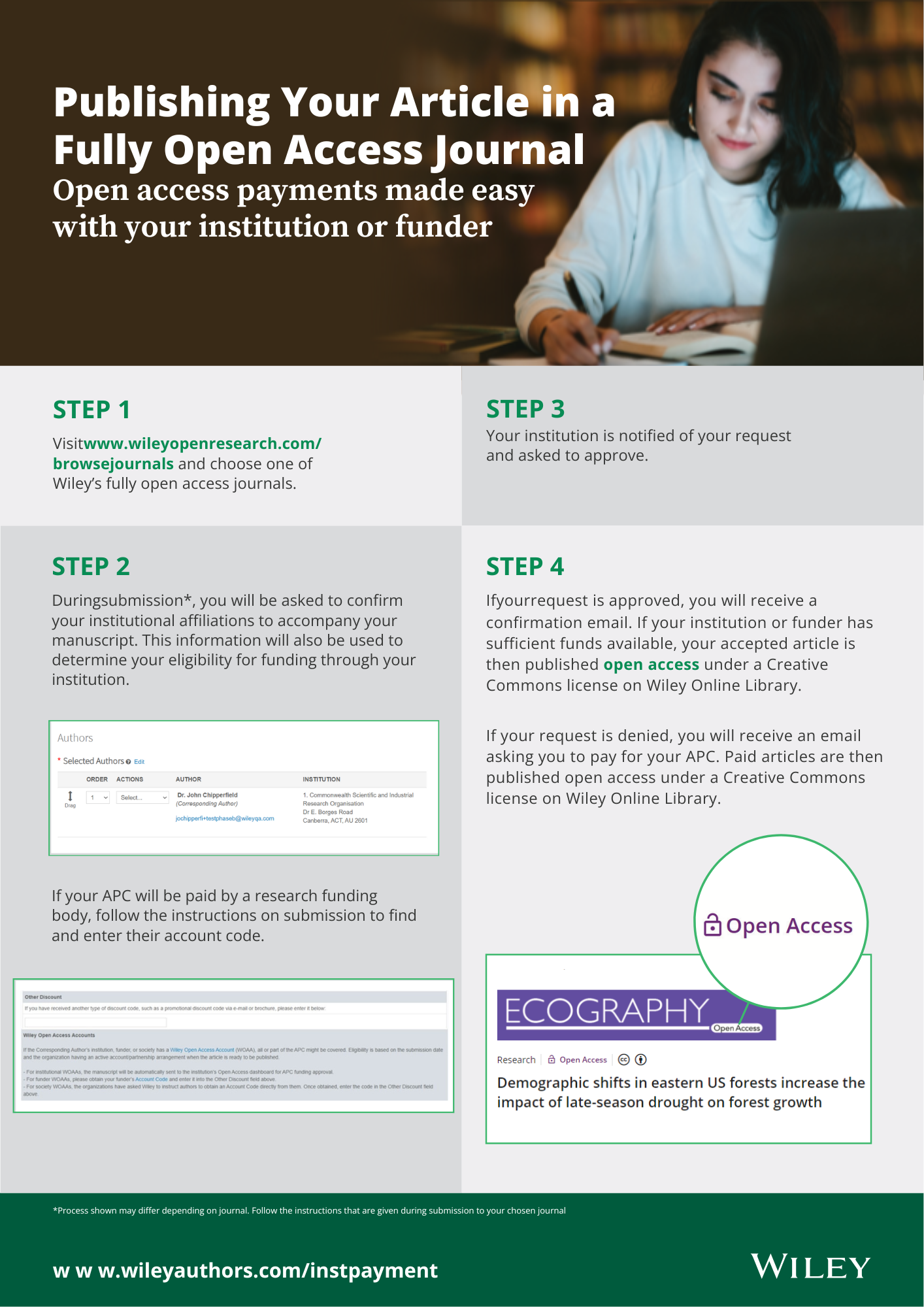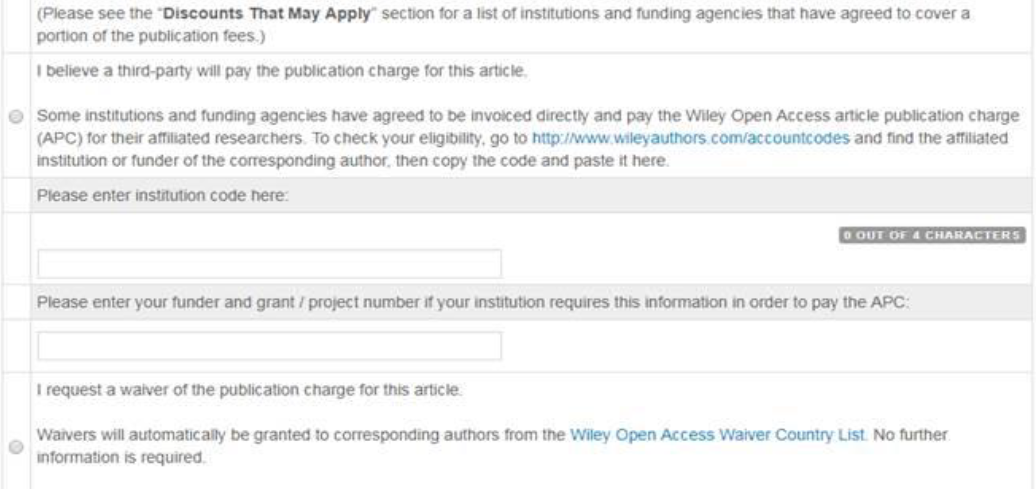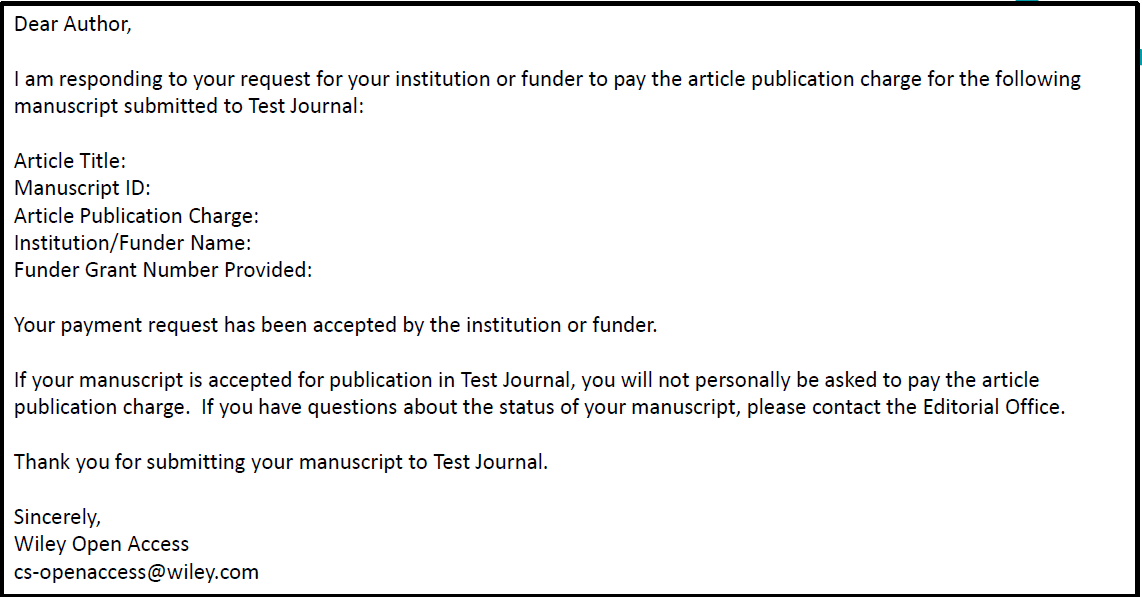Useful information about the open-access publishing and a guide to the publisher's dashboards.
Akadémiai Kiadó
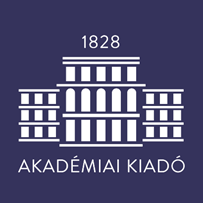
According to the agreement with Akadémiai Kiadó Publishing House, member institutions of the EISZ consortium have the opportunity to publish open access. The agreement applies to hybrid and gold OA journals, the copyright is provided by the Creative Commons CC-BY license. The authors are exempt from the APCs.
Details on the publisher's website:
https://akademiai.com/page/openaccess
What kind of publications are mentioned in the agreement?
The agreement applies to all of the articles submitted by the corresponding authors affiliated with one of the consortium member institutes.
What period?
If the article has been accepted during the term of the agreement, between 01 January 2024 - 31 December 2026.
What kind of journals are available for open-access publishing?
Authors can choose from the publisher's hybrid and Gold Open Access journals.
What types of articles are supported?
- Original research papers
- Review article
- Book review
- Conference Paper
How does the publisher identify the authors?
- Affiliation - name of the member institute
- Unique identification - based on the author's e-mail address
Participating institutions in 2025
- Adventist Theological College
- Apor Vilmos Catholic College
- Báró Wesselényi Miklós Library
- Bekes County Central Hospital
- Biblioteca Municipala Odorheiu Secuiesc
- Bod Péter County Library
- Budapest Business University
- Budapest History Museum
- Budapest University of Technology and Economics
- Corvinus University of Budapest
- Cultural-Education Center Thurzó Lajos
- Dharma Gate Buddhist College
- Eötvös Loránd University
- Eszterhazy Karoly Catholic University
- Ferenc II. Rákóczi County and City Library
- Ferenc Rákóczi II. Transcarpathian Hungarian Institute
- Flór Ferenc Hospital
- Fórum Minority Research Institute
- Gál Ferenc University
- Haáz Rezső Museum
- Hamvas Béla Pest County Library
- Historical Archives of the Hungarian State Security
- Hungarian Academy of Arts
- Hungarian Central Statistical Office Library
- Hungarian Intellectual Property Office
- Hungarian National Museum
- Hungarian University of Agriculture and Life Sciences
- Hungarian University of Sports Science
- HUN-REN Centre for Agricultural Research
- HUN-REN Centre for Ecological Research
- HUN-REN Centre for Energy Research
- HUN-REN Centre for Social Sciences
- HUN-REN Hungarian Research Centre for Linguistics
- HUN-REN Institute of Experimental Medicine
- HUN-REN Research Centre for Natural Sciences
- HUN-REN Research Centre for the Humanities
- HUN-REN Veterinary Medical Research Institute
- HUN-REN Wigner Research Centre for Physics
- Institute for Hungarian Culture in Vojvodina
- Selye University
- Jakabffy Elemér Foundation
- Ján Bocatius Public Library
- Jewish Theological Seminary - University of Jewish Studies, Hungary
- John von Neumann University
- József Attila Library
- Juhász Erzsébet Library
- Kájoni János County Library
- Károli Gáspár University of the Reformed Church in Hungary
- Kishegyes Library
- KTI Institute for Transport Sciences Non-Profit Ltd.
- Lendva Library
- Library and Information Centre of the Hungarian Academy of Sciences
- Library of Matej Hrebenda
- Lucian Blaga Central University Library Cluj-Napoca
- Ludovika University of Public Service
- Lutheran Theological University
- Markusovszky University Teaching Hospital of County Vas
- Mathias Corvinus Collegium
- Medical Centre, Hungarian Defence Forces
- Méliusz Juhász Péter Library
- Metropolitan Ervin Szabó Library
- National Center for Public Health and Pharmacy
- National Directorate General for Hospitals
- National Institute of Oncology
- National Széchényi Library, Budapest, Hungary
- Óbuda University
- Partium Christian University
- Pázmány Péter Catholic University
- Petőfi Literary Museum
- Petz Aladar County Teaching Hospital
- Protestant Theological Institute of Cluj-Napoca
- Raday Collections of the Danubian District of the Hungarian Reformed Church
- Sapientia Hungarian University of Transylvania
- Sapientia College of Theology of Religious Orders
- Sárospatak Reformed Theological Academy
- Seminarium Incarnatae Sapientiae
- Semmelweis University
- St. Andrew Hospital for Rheumatology and Medicinal Spa of Hévíz
- Studentski dom Evropa
- Subotica Library
- Subotica Museum
- Szarvas Gábor Library
- Széchenyi István University
- Székelykeresztúr Library
- Szekler Museum of Ciuc
- Szekler National Museum
- Szent Gyorgy University Teaching Hospital of Fejer County
- Szent Pal Academy
- Transylvanian Museum Society
- University of Arts Targu-Mures
- University of Debrecen
- University of Dunaújváros
- University of Miskolc
- University of Novi Sad
- University of Nyíregyháza
- University of Pannonia
- University of Pécs
- University of Presov
- University of Sopron
- University of Szeged
- University of Tokaj
- University of Veterinary Medicine
- Veritas Research Institute for History and Archives
- Verseghy Ferenc Library and Cultural Institute
American Chemical Society

According to the agreement with the American Chemical Society (ACS), member institutions of the EISZ consortium have the opportunity to publish open access. The agreement applies to all of the publisher's journals, the copyright is provided by a CCC Authors Choice (Creative Commons CC-BY) license. The authors are exempt from the APCs.
Details on the publisher's website:
What kind of publications are mentioned in the agreement?
The agreement applies to all of the articles submitted by the corresponding authors affiliated with one of the consortium member institutes. In 2025, member institutions will be exempt from paying APCs until 91 articles at the consortium level.
What period?
If the article has been accepted during the term of the agreement, until 31 December 2025.
What kind of journals are available for open-access publishing?
Authors can choose from the ACS's hybrid (Author choice) and Gold Open Access journals
What types of articles are supported?
- Original research papers
How does the publisher identify the authors?
- RingGold ID - compared with affiliation
- Affiliation - name of the institution
- Unique identification - based on the author's e-mail address
- bme.hu
- ek.hun-ren.hu; ek-cer.hu
- pte.hu
- semmelweis.hu, semmelweis-univ.hu
- szte.hu, u-szeged.hu
- ttk.hun-ren.hu; ttk.hu, ttk.mta.hu
- wigner.hun-ren.hu; wigner.hu, wigner.mta.hu
How may I use the open access publishing option?
1. Articles can be submitted through ACS Paragon Plus. The corresponding author should name the institution and submit the proper e-mail address in the affiliation, which is optional in the drop-down menu.
2. After the article is accepted, the author receives a confirmation e-mail, which contains a link to the Copyright Clearance Center website. Here you may apply for the Open Access publishing.
3. On the next page, please choose the “Seek funding from Hungarian Electronic Information Service National Programme” option.
4. Open Access charge shows 0 $ total price. According to the agreement, the APCs are free of charge. For approval, please click on the "NEXT" button.
5. On the last page, there is an Order Review. Click on the "Submit for approval" button to approve the transaction and submit the manuscript for OA publishing (before that, check out of the box at the "I have read and accept the terms and conditions").
Brill Journals
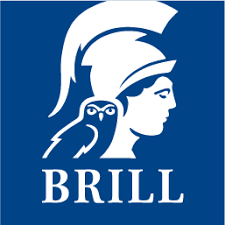
According to the agreement with Brill, member institutions of the EISZ consortium have the opportunity to publish open access. The agreement applies to all of the publisher's journals, the copyright is provided by a Creative Commons CC-BY license. The authors are exempt from the APCs.
Details on the publisher's website:
https://brill.com/page/oageneral/general-open-access-information
What kind of publications are mentioned in the agreement?
The agreement applies to all of the articles submitted by the corresponding authors affiliated with one of the consortium member institutes.
What period?
If the article has been accepted during the term of the agreement, until 31 December 2025.
What kind of journals are available for open-access publishing?
Authors can choose from Brill's hybrid and Gold Open Access journals.
What types of articles are supported?
- Research Article
- Review Article
How does the publisher identify the authors?
- Affiliation - name of the institution
- Unique identification - based on the author's e-mail address
- Persistent identifiers, such as Ringgold, ORCID or other recognized institutional identifiers; and/or by IP range
British Medical Journals

According to the agreement with the British Medical Journals (BMJ), member institutions of the EISZ consortium have the opportunity to publish open access. The agreement applies to all of the publisher's online hybrid and Gold Open Access journals, the copyright is provided by a Creative Commons CC-BY and CC-BY-NC license. The authors are exempt from the APCs.
Details on the publisher's website:
https://authors.bmj.com/open-access-hungary/
What kind of publications are mentioned in the agreement?
The agreement applies to all of the articles submitted by the corresponding authors affiliated with one of the consortium member institutes.
What period?
If the article has been accepted during the term of the agreement, until 31 December 2025.
What kind of journals are available for open-access publishing?
In hybrid and Gold Open Access journals of the BMJ.
What types of articles are supported?
Information on eligible article types
| Hybrid journals: |
Gold OA journals: |
|
| Clinical audit
Clinical science |
4th World Trauma Congress article |
How does the publisher identify the authors?
- Affiliation - name of the institution
- Unique identification - based on the author's e-mail address
- Ringgold ID
Cambridge University Press Journals

According to the agreement with Cambridge University Press, member institutions of the EISZ consortium have the opportunity to publish open access. The agreement applies to hybrid journals, the copyright is provided by the Creative Commons CC-BY, CC-BY-NC-SA and CC-BY-NC-ND licenses. The authors are exempt from the APCs.
Details on the publisher's website:
What kind of publications are mentioned in the agreement?
The agreement applies to all of the articles submitted by the corresponding authors affiliated with one of the consortium member institutes.
What period?
If the article has been accepted during the term of agreement, until 31 December 2025.
What kind of journals are available for open-access publishing?
In hybrid and Gold Open Access journals of Cambridge University Press.
What types of articles are supported?
Description of the eligible article types
- Original research papers
- Review article
- Case Report
- Brief Report
- Rapid Communications
How does the publisher identify the authors?
- Affiliation - name of the institution
- Unique identification - based on the author's e-mail address
- ORCID
Participating institutions in 2025
- Dennis Gabor University of Applied Sciences
- Eötvös Loránd University
- Eszterhazy Karoly Catholic University
- Hungarian Central Statistical Office Library
- Hungarian National Museum Public Collection Centre, Budapest
- Hungarian University of Agriculture and Life Sciences
- HUN-REN Alfréd Rényi Institute of Mathematics
- HUN-REN Centre for Economic and Regional Studies
- HUN-REN Centre for Social Sciences
- HUN-REN Hungarian Research Centre for Linguistics
- HUN-REN Institute for Nuclear Research
- HUN-REN Research Centre for the Humanities
- Institute of Advanced Studies Kőszeg
- John von Neumann University
- Károli Gáspár University of the Reformed Church in Hungary
- Library and Information Centre of the Hungarian Academy of Sciences
- Ludovika University of Public Service
- Mathias Corvinus Collegium
- Óbuda University
- Pázmány Péter Catholic University
- Semmelweis University
- Széchenyi István University
- The Office of the National Assembly
- University of Debrecen
- University of Miskolc
- University of Pécs
- University of Szeged
- University of Tokaj
- University of Veterinary Medicine
How may I use the open access publishing option?
1. You may find all of the information about the manuscript preparation and open access criteria on the Cambridge Core website. cambridge.org/check-your-oa-eligibility
It's important to add the precise name of the institution and use the institutional e-mail address on the manuscript.
2. You have to submit your prepared manuscript through the Cambridge Core system. Click on the „Submit your article” button.
3. For submission, you should create a new account or use your ORCID ID. Navigate to the „Start New Submission” menu, where you can submit the manuscript (Begin Submission).
4. After the submission the manuscript gets a peer-review status, which is confirmed to the author via e-mail.
5. When the manuscript is accepted, the system sends a notification e-mail, which briefs the author about open-access publishing and contains a link to the OA dashboard.
6. The link shows the journal's open-access information page, where you should make a statement about whether you want to use the OA publishing option. Click on the „Open Access Articles” part, if you would like to make your article open access.
7. The system identifies the eligibility based on the affiliation and ensures the author that APCs are free according to the agreement. The author has no further task to do. Authors, who chose the non-OA option earlier, but have eligibility for open access, had the possibility to turn their articles OA retrospectively. They only have to send an e-mail to the publisher’s support.
De Gruyter

According to the agreement with De Gruyter, member institutions of the EISZ consortium have the opportunity to publish open access. The agreement applies to all of the publisher's online hybrid and Gold Open Access journals, the copyright is provided by Creative Commons CC-BY and CC-BY-NC licenses. The authors are exempt from the APCs.
Details on the publisher's website:
https://www.degruyter.com/publishing/publications/openaccess/fundingsupport
What kind of publications are mentioned in the agreement?
The agreement applies to all of the articles submitted by the corresponding authors affiliated with the consortium member institutes. According to the agreement, member institutions will be exempt from paying APCs.
What period?
If the article has been accepted during the term of agreement, until 31 December 2025.
What kind of journals are available for open-access publishing?
Authors can choose from De Gruyter's online hybrid and Gold Open Access journals.
What types of articles are supported?
- Original Article, Original Research, Research Paper
- Review Article
- Brief Communication (Letter)
- Continuing Education
- Case Reports
How does the publisher identify the authors?
- Affiliation - the name of the institution
- Unique identification - based on the author's email address
Participating institutions in 2025
- Hungarian National Museum Public Collection Centre, Budapest (Social Sciences and Humanities Package)
- HUN-REN Hungarian Research Centre for Linguistics (Social Sciences and Humanities Package)
- HUN-REN Research Centre for the Humanities (Social Sciences and Humanities Package)
- Károli Gáspár University of the Reformed Church in Hungary (Complete Package)
- Ludovika University of Public Service (Complete Package)
- Mathias Corvinus Collegium (Social Sciences and Humanities Package)
- Óbuda University (Complete Package)
- Pázmány Péter Catholic University (Social Sciences and Humanities Package)
- Sárospatak Reformed Theological University (Social Sciences and Humanities Package)
- Semmelweis University (Science, Technology and Medicine Package)
- The Office of the National Assembly (Social Sciences and Humanities Package)
- University of Debrecen (Science, Technology and Medicine Package)
- University of Miskolc (Complete Package)
- University of Pécs (Social Sciences and Humanities Package)
- University of Szeged (Complete Package)
How may I use the open access publishing option?
On the Copyright Clearance Center's (CCC) RightsLink for Scientific Communications (RLSC) is possible to treat APCs. After the submission, the corresponding author receives a confirmation e-mail, which contains a link to the RLSC website.
If you don't have one, please create an account on RightsLink. It's important to use your institutional e-mail address, the same address you added on your manuscript.
The system identifies the institution with the e-mail address. You may choose the „Seek funding from the Hungarian Electronic Information Service National Programme” option.
According to the agreement, APC is free. The system indicates a 0 $ total fee. You should move on with the "Next" button.
If you have read the Terms and Conditions, click on the small box at the right bottom of the page. Clicking on the „Submit For Approval” button you can submit your article as open access.
The system will send you a confirmation when it is accepted.
Elsevier
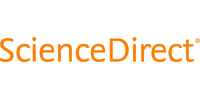
According to the agreement with Elsevier, member institutions of the EISZ consortium have the opportunity to publish open access through ScienceDirect. The agreement applies to all of the publisher's online hybrid and Gold Open Access journals, the copyright is provided by Creative Commons CC-BY and CC-BY-NC-ND licenses. The authors are exempt from the APCs.
Details on the publisher's website:
https://www.elsevier.com/about/open-science/open-access/agreements/hungary
What kind of publications are mentioned in the agreement?
The agreement applies to all of the articles submitted by the corresponding authors affiliated with one of the consortium member institutes.
What period?
If the article has been accepted during the term of the agreement, until 31 December 2025.
What kind of journals are available for open-access publishing?
Authors can choose from Elsevier's 2000 hybrid and Gold OA journals. Lancet and Cell journals are an exception.
List of Journals (Updated: 12 May 2025)
What types of articles are supported?
- Case reports
- Data in Briefs
- Full-length articles
- Micro-articles
- Original software publication
- Practice guidelines
- Protocols
- Review articles
- Replication studies
- Short communications
- Short surveys
- Video articles
How does the publisher identify the authors?
Affiliation - the name of the institution
Affiliation - optional when submitting an article from the list
Participating institutions in 2025
- Bay Zoltán Nonprofit Ltd. for Applied Research
- Budapest University of Technology and Economics
- Corvinus University of Budapest
- ELI-HU Non-profit Ltd.
- Eötvös Loránd University
- Eszterhazy Karoly Catholic University
- Gottsegen György Hungarian Institute of Cardiology
- Hungarian University of Agriculture and Life Sciences
- Hungarian University of Sports Science
- HUN-REN Alfréd Rényi Institute of Mathematics
- HUN-REN Balaton Limnological Research Institute
- HUN-REN Biological Research Center, Szeged
- HUN-REN Centre for Agricultural Research
- HUN-REN Centre for Ecological Research
- HUN-REN Centre for Economic and Regional Studies
- HUN-REN Centre for Energy Research
- HUN-REN Institute for Computer Science and Control
- HUN-REN Institute for Nuclear Research
- HUN-REN Institute of Earth Physics and Space Science
- HUN-REN Research Centre for Astronomy and Earth Sciences
- HUN-REN Research Centre for Natural Sciences
- HUN-REN Veterinary Medical Research Institute
- HUN-REN Wigner Research Centre for Physics
- John von Neumann University
- Library and Information Centre of the Hungarian Academy of Sciences
- National Center for Public Health and Pharmacy
- National Institute of Oncology
- Óbuda University
- Pázmány Péter Catholic University
- Sapientia Hungarian University of Transylvania
- Semmelweis University
- Supervisory Authority of Regulatory Affairs
- Széchenyi István University
- University of Debrecen
- University of Dunaújváros
- University of Miskolc
- University of Nyíregyháza
- University of Pannonia
- University of Pécs
- University of Sopron
- University of Szeged
- University of Tokaj
- University of Veterinary Medicine
How may I use the open access publishing option?
1. Corresponding authors can choose their affiliation member institution from the drop-down menu.
2. If there are more co-authors, please add their names (Yes or No question). Under the „Add Co-author Details”, you have to write the first and last name and the institution of the co-author. On the next page, you can add the funding also with the exact name below (Funder Details).
3. After that you should do the Open Access setting. According to the affiliation (date of submission, journal's name) the system shows the options, where the Gold Open Access is by default. If your article has been approved by the administrator of the member institution, you can publish open access and the APCs are free of charge. If your article is rejected, you have to pay the APCs.
4. If you choose the Gold Open Access option, you have to add the Creative Commons license type. You can choose from two options, CC-BY 4.0 allows the authors, they read and use for their own commercial purposes the publication. CC-BY-NC-ND 4.0 gives permission only for reading and non-commercial purposes.
5. Authors can check their settings on the Review Order page, and then they should approve with the "Finish" button. Authors will receive a confirmation e-mail from Elsevier.
6. You may add other institutions to the affiliation. Choose the type of publication first, then the institution's name.
You can add further authors also as you go through the menu items.
In the case of mirror journals, authors have the chance to send their publication to mirror open-access journals, without paying for the APCs.
Emerald

According to the agreement with Emerald, member institutions of the EISZ consortium have the opportunity to publish open access. The agreement applies to subscribed hybrid journals and all Gold Open Access journals, the copyright is provided by the Creative Commons CC-BY and CC-BY-NC license. The authors are exempt from the APCs.
Details on the publisher's website:
What kind of publications are mentioned in the agreement?
The agreement applies to all of the articles submitted by the corresponding authors affiliated at one of the consortium member institutes. This year's quotas ran out in April.
What period?
If the article has been accepted during the term of the agreement, until 31 December 2025.
What kind of journals are available for open-access publishing?
In the case of Emerald's hybrid journals, the author can choose from the journals of the package subscribed by the institution and all Gold Open Access journals.
What types of articles are supported?
- Original research papers
How does the publisher identify the authors?
- Affiliation - the name of the institution
- Ringgold ID
- Unique identification - based on the author's e-mail address
Participating institutions in 2025
- Budapest Business University (Emerald Premier)
- Budapest University of Technology and Economics (Emerald Premier)
- Corvinus University of Budapest (Emerald Premier)
- Educational Authority (Education)
- Hungarian National Museum Public Collection Centre, Budapest (Library and Information Sciences)
- International Business School (EMAN)
- Ludovika University of Public Service (Emerald Premier)
- Széchenyi István University (Emerald Premier)
- University of Pécs (Emerald Premier)
- University of Sopron (Emerald Premier)
IEEE

According to the agreement with the Institute of Electrical and Electronics Engineers (IEEE) publisher, member institutions of the EISZ consortium have the opportunity to publish open access. The agreement applies to all of the publisher's hybrid and Gold Open Access journals, the copyright is provided by Creative Commons CC-BY and CC-BY-NC licenses. The authors are exempt from the APCs.
Details on the IEEE's website:
What kind of publications are mentioned in the agreement?
The agreement applies to all of the articles submitted by the corresponding authors affiliated with one of the consortium member institutes. In 2025, member institutions will be exempt from paying APCs until 50 articles at the consortium level.
What period?
If the article has been accepted during the term of agreement, until 31 December 2025.
What kind of journals are available for open-access publishing?
Authors can choose from IEEE's hybrid and Gold Open Access journals.
What types of articles are supported?
- Original research papers
How does the publisher identify the authors?
- Affiliation - the name of the institution
- Ringgold ID
- Unique identification - based on the author's e-mail address
Participating institutions in 2025
- Budapest University of Technology and Economics (IEEE Electronic Library)
- Eötvös Loránd University (IEEE Electronic Library)
- HUN-REN Institute for Computer Science and Control (IEEE Electronic Library)
- John von Neumann University (IEEE Electronic Library)
- Ludovika University of Public Service (IEEE Electronic Library)
- Óbuda University (IEEE Electronic Library)
- Pázmány Péter Catholic University (IEEE All-Society Periodicals Package)
- Széchenyi István University (IEEE Electronic Library)
- University of Pécs (IEEE Electronic Library)
- University of Szeged (IEEE Electronic Library)
IOP Publishing

According to the agreement with IOP Publishing, member institutions of the EISZ consortium have the opportunity to publish open access through IOPScience. The agreement applies to all of the publisher's hybrid and Gold Open Access journals, the copyright is provided by a Creative Commons CC-BY license. The authors are exempt from the APCs.
Details on the publisher's website:
https://publishingsupport.iopscience.iop.org/questions/open-access-hungary/
What kind of publications are mentioned in the agreement?
The agreement applies to all of the articles submitted by the corresponding authors affiliated with one of the consortium member institutes.
What period?
If the article has been accepted during the term of agreement, until 31 December 2025.
What kind of journals are available for open-access publishing?
Authors can choose from IOP Science Hybrid and Gold Open Access journals.
What types of articles are supported?
- Research papers
- Special issue papers
- Letters
- Review
How does the publisher identify the authors?
- Affiliation - the name of the institution
- Unique identification - based on the author's e-mail address
How may I use the open access publishing option?
Choose an OA journal and submit your manuscript. At the affiliation part, you should add the precise name of the institution, which is a member of the open access agreement.
During the peer-review, the article will be identified according to the affiliation. After that, the corresponding author receives a notification about the open-access publishing option. For OA publishing you should accept the CC-BY license. If you withdraw from the opportunity, you have to indicate this within five days.
IOP is going to ask from consortium administrator to verify the OA eligibility. If your article has been rejected, you still have the opportunity to publish traditionally in hybrid journals.
The article, approved by the administrator will publish open access according to the CC-BY license. APCs are free of charge.
Lippincott Williams & Wilkins

According to the agreement with Wolters Kluwer, researchers from universities participating in the EISZ consortium have the opportunity to publish open access. The agreement applies to all of the Lippincott Williams & Wilkins journals, the copyright is provided by a Creative Commons CC-BY license. The authors are exempt from the APCs.
What kind of publications are mentioned in the agreement?
The agreement applies to all the articles submitted by the corresponding authors affiliated with one of the consortium member universities. In 2025, universities will be exempt from paying APCs until 18 articles at the consortium level.
What period?
If the article has been accepted during the term of agreement, until 31 December 2025.
What kind of journals are available for open-access publishing?
Authors can choose from Lippincott Williams & Wilkins online hybrid journals.
List of Journals - Universities
List of Journals - Gottsegen National Cardiovascular Center
What types of articles are supported?
- Original research papers
How does the publisher identify the authors?
- Affiliation - the name of the member institute
- Unique identification - based on the author's e-mail address
- RingGold ID - compared with affiliation
How may I use the open access publishing option?
On the Copyright Clearance Center's (CCC) RightsLink for Scientific Communications (RLSC) is possible to treat APCs. After the submission, the corresponding author receives a confirmation e-mail, which contains a link to the RLSC website.
If you don't have one, please create an account on RightsLink. It's important to use your institutional e-mail address, the same address you added to your manuscript.
The system identifies the institution with the e-mail address. You may choose the „Seek funding from the Hungarian Electronic Information Service National Programme” option.
According to the agreement, APC is free. The system indicates a 0 $ total fee. You should move on with the "Next" button.
If you have read the Terms and Conditions, click on the small box at the right bottom of the page. Clicking on the „Submit For Approval” button you can submit your article as open access.
The system will send you a confirmation when it is accepted.
Oxford University Press Journals

According to the agreement with Oxford University Press, member institutions of the EISZ consortium have the opportunity to publish open access. The agreement applies to hybrid journals, the copyright is provided by the Creative Commons or equivalent licenses. The authors are exempt from the APCs.
Details on the publisher's website:
What kind of publications are mentioned in the agreement?
The agreement applies to all of the articles submitted by the corresponding authors affiliated with one of the consortium member institutes.
What period?
If the article has been accepted and Received Into Production during the term of the agreement, until 31 December 2025.
What kind of journals are available for open-access publishing?
Authors can choose from Oxford University Press's online hybrid journals.
What types of articles are supported?
- Research Article
- Review Article
- Case Report
- Brief Report
How does the publisher identify the authors?
- Unique identification - based on the author's e-mail address
Participating institutions in 2025
- Corvinus University of Budapest
- Eötvös Loránd University
- HUN-REN Centre for Economic and Regional Studies
- HUN-REN Hungarian Research Centre for Linguistics
- HUN-REN Research Centre for the Humanities
- Károli Gáspár University of the Reformed Church in Hungary
- Library and Information Centre of the Hungarian Academy of Sciences
- Ludovika University of Public Service
- Mathias Corvinus Collegium
- National Office for the Judiciary
- Semmelweis University
- The Office of the National Assembly
- University of Debrecen
- University of Miskolc
- University of Pécs
- University of Szeged
Royal Society of Chemistry
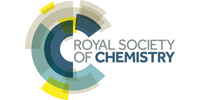
According to the agreement with the Royal Society of Chemistry (RSC), member institutions of the EISZ consortium have the opportunity to publish open access. The agreement applies to all of the publisher's online hybrid open-access journals, the copyright is provided by Creative Commons CC-BY and CC-BY-NC licenses. The authors are exempt from the APCs.
Details on the publisher's website:
https://www.rsc.org/journals-books-databases/open-access/read-and-publish/
What kind of publications are mentioned in the agreement?
The agreement applies to all of the articles submitted by the corresponding authors affiliated with one of the consortium member institutes.
What period?
If the article has been accepted during the term of the agreement, until 31 December 2025.
What kind of journals are available for open-access publishing?
Authors can choose from RSC's hybrid and Gold Open Access journals.
What types of articles are supported?
- Original research papers
How does the publisher identify the authors?
- Unique identification - based on the author's e-mail address
How may I use the open access publishing option?
1. You should check the institution's eligibility for open-access publishing first.
2. Choose a journal where you would like to submit your manuscript.
3. In the affiliation you have to add the precise name of the institution and e-mail address.
4. After submission, you receive a confirmation e-mail, where a link guides you to the RSC dashboard site.
5. On the RSC dashboard, all information about the manuscript can be checked, but these information can not be changed this time. Click on the „Start Now” button to move to the open access settings.
6. You can choose from the two open-access publishing options. If you choose from the Standard (not OA) option, you receive a notification that your institution is not eligible for your preferred publishing form.
7. If you choose the Gold OA option on the right side, you should add the Creative Commons license (two options).
8. If you choose the CC license, then you have to check the small box, that you agree with CC terms and conditions. Click on the „Continue” button to move on.
9. You receive a confirmation that the institution has already paid for APCs.
10. On the last page, you should verify the settings, and then approve it with the „Confirm and finish” button.
Sage

According to the agreement with Sage, member institutions of the EISZ consortium have the opportunity to publish open access. The agreement applies to hybrid journals, the copyright is provided by the Creative Commons CC-BY and CC-BY-NC licenses. The authors are exempt from the APCs.
Details on the publisher's website:
https://uk.sagepub.com/en-gb/eur/hungary-eisz
What kind of publications are mentioned in the agreement?
The agreement applies to all of the articles submitted by the corresponding authors affiliated with one of the consortium member institutes.
What period?
If the article has been accepted during the term of the agreement, until 31 December 2025.
What kind of journals are available for open-access publishing?
Authors can choose from the journals of the package subscribed by their participating institution.
What types of articles are supported?
- Original Research Papers
- Review Papers
- Brief Communications
- Short Reports
- Case Reports
How does the publisher identify the authors?
- Affiliation - name of the institution
- Unique identification - based on the author's e-mail address
- Ringgold ID
Participating institutions in 2025
- Corvinus University of Budapest (HSS)
- HUN-REN Centre for Social Sciences (HSS)
- Ludovika University of Public Service (Premier)
- Mathias Corvinus Collegium (HSS)
- Metropolitan Ervin Szabó Library (HSS)
- Moholy-Nagy University of Art and Design (HSS)
- Pázmány Péter Catholic University (HSS)
- Semmelweis University (STM)
- University of Debrecen (STM)
- University of Pécs (Premier)
- University of Szeged (Premier)
Springer Nature

According to the agreement with Springer Nature, member institutions of the EISZ consortium have the opportunity to publish open access. The agreement applies to more than 2000 hybrid and 600 gold open-access journals (including BMC, Nature Research, Palgrave and SpringerOpen). The copyright is provided by a Creative Commons CC-BY and CC BY-NC (in the case of hybrid journals) license. The authors are exempt from the APCs.
Details on the publisher's website:
https://www.springernature.com/gp/open-research/institutional-agreements/oaforhungary
What kind of publications are mentioned in the agreement?
The agreement applies to all of the articles submitted by the corresponding authors affiliated with one of the consortium member institutes.
What period?
If the article has been accepted during the term of agreement, until 31 December 2025.
What kind of journals are available for open-access publishing?
Authors can choose from Springer Nature's hybrid (open choice) and Gold OA (Fully OA) journals. In 2025, member institutions will be exempt from paying APCs up to a maximum of 477 articles (This year's quotas ran out on August 21st.) in Fully OA journals and 630 articles in hybrid journals at the consortium level.
What Types of articles are supported?
Original articles (Original Article, Original Research, Original Paper, Research Paper and Case Report)
Review articles (Review Article)
Brief Communication (Letter)
Continuing Education
How does the publisher identify the authors?
Affiliation - optional when submitting an article from the list
Unique identification - based on the author's e-mail address
IP address
Participating institutions in 2025
- Budapest University of Economics and Business
- Budapest University of Technology and Economics
- Corvinus University of Budapest
- ELI-HU Non-profit Ltd.
- Eötvös Loránd University
- Eszterhazy Karoly Catholic University
- Hungarian University of Agriculture and Life Sciences
- Hungarian University of Sports Science
- HUN-REN Alfréd Rényi Institute of Mathematics
- HUN-REN Balaton Limnological Research Institute
- HUN-REN Biological Research Center, Szeged
- HUN-REN Centre for Agricultural Research
- HUN-REN Centre for Ecological Research
- HUN-REN Centre for Economic and Regional Studies
- HUN-REN Centre for Energy Research
- HUN-REN Centre for Social Sciences
- HUN-REN Hungarian Research Centre for Linguistics
- HUN-REN Institute for Computer Science and Control
- HUN-REN Institute for Nuclear Research
- HUN-REN Institute of Earth Physics and Space Science
- HUN-REN Research Centre for Astronomy and Earth Sciences
- HUN-REN Research Centre for Natural Sciences
- HUN-REN Veterinary Medical Research Institute
- HUN-REN Wigner Research Centre for Physics
- John von Neumann University
- Library and Information Centre of the Hungarian Academy of Sciences
- Ludovika University of Public Service
- Markusovszky University Teaching Hospital of County Vas
- Mathias Corvinus Collegium
- National Institute of Oncology
- Óbuda University
- Pázmány Péter Catholic University
- Sapientia Hungarian University of Transylvania
- Semmelweis University
- Supervisory Authority of Regulatory Affairs
- Széchenyi István University
- University of Debrecen
- University of Miskolc
- University of Pannonia
- University of Pécs
- University of Sopron
- University of Szeged
- University of Tokaj
- University of Veterinary Medicine
How may I use open access publishing option in hybrid (Open Choice) journals?
The flow chart shows the hybrid publishing process.
Guide for authors is available here.
1. Check, that your institution is participating in the agreement with Springer Nature.
2. Choose a journal and submit your manuscript.
3. If the article has been accepted, you receive a confirmation e-mail with a link to Springer My Publication website.
4. Identify your eligibility: choose your affiliation (name of the institution) from the drop-down list.
5. When you choose the institution, the system is going to show you in the green box, that your institution is part of the agreement. For further identification, the system examines the institutional e-mail address and the IP address of the institutional network.
6. The open access agreement covers the APCs, authors only have to verify the submission by pressing the "Continue" button.
7. If the institution is not part of the open access agreement, a yellow box will appear below, which contains more instructions.
8. The corresponding author can choose between two options: publish the article as OA paying the APC or publish the article without open access.
9. On the next page accept the OA license.
10. On the last page you may see all the information about the order. If you find everything is OK, click on the small box in the Total Amount field and send it with the "Order for free" button.
How may I use open access publishing option in Gold Open Access journals?
1. When the article has been accepted for publishing, the corresponding author receives an e-mail invitation to verify the affiliation through the Springer Nature dashboard.
2. You can add the name of your institution to the blank field. The system will show the matches, when you have found your institution, click on "Confirm this is my affiliation".
3. If the system doesn't find any matches, a small box will appear below with a similar name of your institution.
4. If the system finds a match with the affiliation, the institution name appears on the box. You should wait until the institutional administrator verifies the affiliation.
5. When the institutional administrator approves the affiliation, you receive a confirmation e-mail and a notification also on the dashboard.
6. If the submitted article doesn't match the agreement or is rejected, the corresponding author receives an e-mail notice, which links to the APC payment site. This page doesn't appear if the article has been accepted before.
Taylor & Francis Online
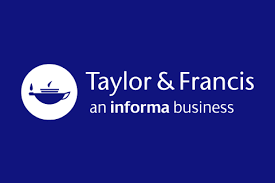
According to the agreement with Taylor & Francis, member institutions of the EISZ consortium have the opportunity to publish open access. The agreement applies to hybrid journals, the copyright is provided by the Creative Commons CC-BY, CC-BY-NC and CC-BY-NC-ND licenses. The authors are exempt from the APCs.
Details on the publisher's website:
https://www.tandfonline.com/openaccess/members/eisz
What kind of publications are mentioned in the agreement?
The agreement applies to all of the articles submitted by the corresponding authors affiliated with one of the consortium member institutes. In 2025, member institutions will be exempt from paying APCs until 60 articles at the consortium level. This year's quotas ran out on August 14th.
What period?
If the article has been accepted during the term of the agreement, until 31 December 2025.
What kind of journals are available for open-access publishing?
Authors can choose from Taylor & Francis' online hybrid journals.
What types of articles are supported?
- Original Papers
- Review Papers
How does the publisher identify the authors?
- Affiliation - name of the institution
- Unique identification - based on the author's e-mail address
- Ringgold ID
Participating institutions in 2025
- Corvinus University of Budapest (Social Sciences & Humanitites Library)
- HUN-REN Centre for Social Sciences (Social Sciences & Humanitites Library)
- Károli Gáspár University of the Reformed Church in Hungary (Social Sciences & Humanitites Library ; Science & Technology)
- Ludovika University of Public Service(Social Sciences & Humanitites Library ; Science & Technology)
- Mathias Corvinus Collegium (Social Sciences & Humanitites Library)
- Metropolitan Ervin Szabó Library (Social Sciences & Humanitites Library)
- Moholy-Nagy University of Art and Design (Social Sciences & Humanitites Library)
- Pázmány Péter Catholic University (Social Sciences & Humanitites Library)
- Semmelweis University(Medical Library)
- Széchenyi István University (Social Sciences & Humanitites Library)
- University of Pécs (Social Sciences & Humanitites Library ; Medical Library ; Science & Technology)
- University of Sopron (Science & Technology)
- University of Szeged (Social Sciences & Humanitites Library ; Medical Library ; Science & Technology)
Wiley

According to the agreement with Wiley, member institutions of the EISZ consortium have the opportunity to publish open access. The agreement applies to all of the publisher's hybrid OnlineOpen and Gold Open Access journals, the copyright is provided by Creative Commons CC-BY, CC-BY-NC, CC-BY-ND and CC-BY-NC-ND licenses. The authors are exempt from the APCs.
Details on the publisher's website:
What kind of publications are mentioned in the agreement?
The agreement applies to all of the articles submitted by the corresponding authors affiliated with one of the consortium member institutes. In 2025, member institutions will be exempt from paying APCs up to a maximum of 85 articles in Gold OA journals and 225 articles in hybrid journals at the consortium level.
What period?
If the article has been accepted during the term of the agreement, until 31 December 2025.
What kind of journals are available for open-access publishing?
Authors can choose from the publisher's hybrid and Gold Open Access journals.
What types of articles are supported?
Description of the eligible article types
- Case Study
- Commentary
- Data Article
- Education
- Lecture
- Method and Protocol
- Perspective
- Practice and Policy
- Rapid Publication
- Research Article
- Review Article
- Short Communication
- Technical Note
How does the publisher identify the authors?
- Affiliation - name of the member institute
- Affiliation - optional when submitting an article from the list
- Unique identification - based on the author's e-mail address
- Ringgold ID
Participating institutions in 2025
- Budapest University of Technology and Economics
- Eötvös Loránd University
- Hungarian University of Agriculture and Life Sciences
- HUN-REN Biological Research Center, Szeged
- HUN-REN Centre for Ecological Research
- HUN-REN Centre for Energy Research
- HUN-REN Research Centre for Natural Sciences
- Károli Gáspár University of the Reformed Church in Hungary
- Mathias Corvinus Collegium
- Pázmány Péter Catholic University
- Semmelweis University
- Széchenyi István University
- University of Debrecen
- University of Pécs
- University of Szeged
- University of Veterinary Medicine
How may I use open access publishing option in Hybrid OnlineOpen journals?
Hybrid OnlineOpen publishing step by step.
1. Invitation letter: when the article has been accepted, the corresponding author receives an invitation e-mail from Wiley. The e-mail shows, that the added institution in the affiliation is a member institution of the EISZ consortium and eligible for open-access publication.
2. Go to Wiley Author Services and click on My Dashboard. On the Action Required (blue field below), there are two options:
- Sign License: the author gives a copyright license to the article.
-Select OnlineOpen: which leads you to Hybrid OnlineOpen.
3. Affiliation: choose the name of your institution or add another one to the affiliation. It's important to write the precise name of your institution, otherwise, the system is not able to find any matches. On the next page, add the funder's name.
4. Here you can set your article as OnlineOpen. You should choose between "Yes" or "No" options, after clicking on the „Confirm” button.
5. On the next page you have to set up the Copyright Ownership. Choose the right one from the drop-down list.
6. If you choose the OnlineOpen option, set up the Creative Commons (CC) license. The type of license depends on the funder's name. After clicking on the „OK” button.
Then click on Save & Sign to save the CC license.
In the end, you receive the copy of the license agreement. Click on the small box below, the Contributor's Name and confirm the license with the „Sign” button.
7. On the last page the system shows that they accepted the CC license registration. The article is OpenOnline finally.
How may I use open access publishing option in Gold Open Access journals?
Gold Open Access publishing step by step.
1. Submit your manuscript, and then you should generate an institutional code on Author Service.
2. You receive a confirmation e-mail when the code for Author Services has been approved.
3. When the article has been accepted, the license agreement will be established. No further charges for the author.
